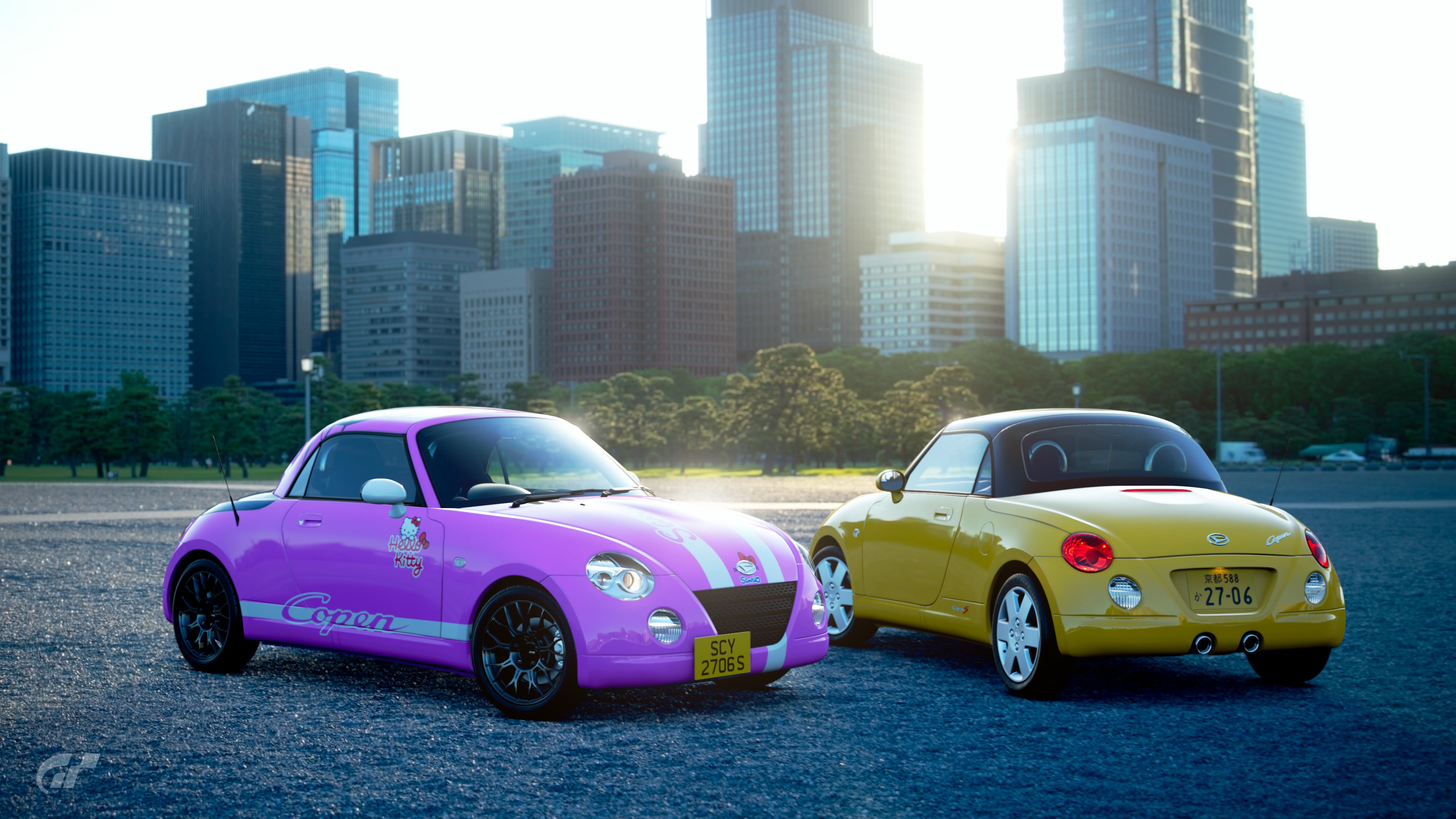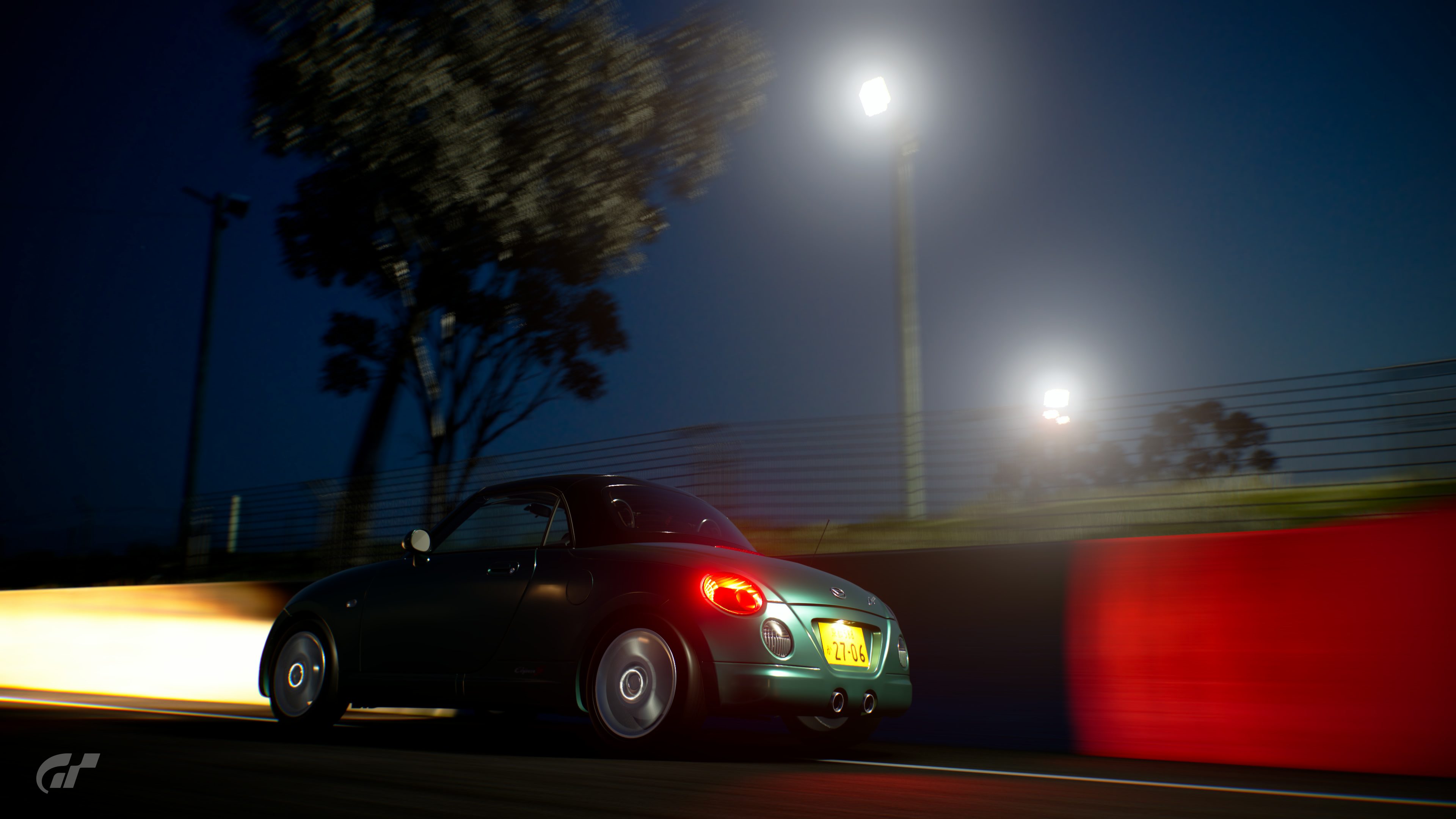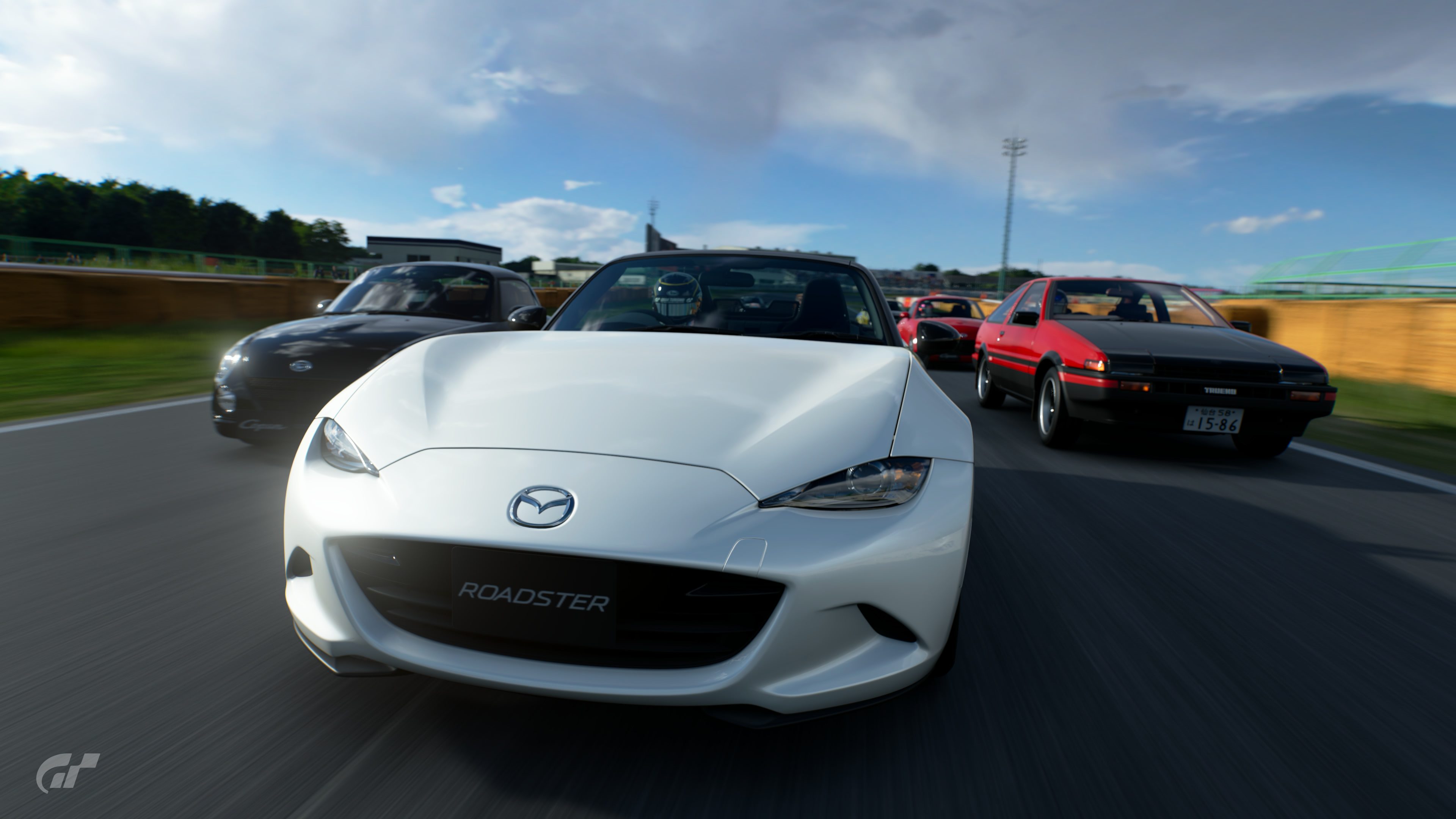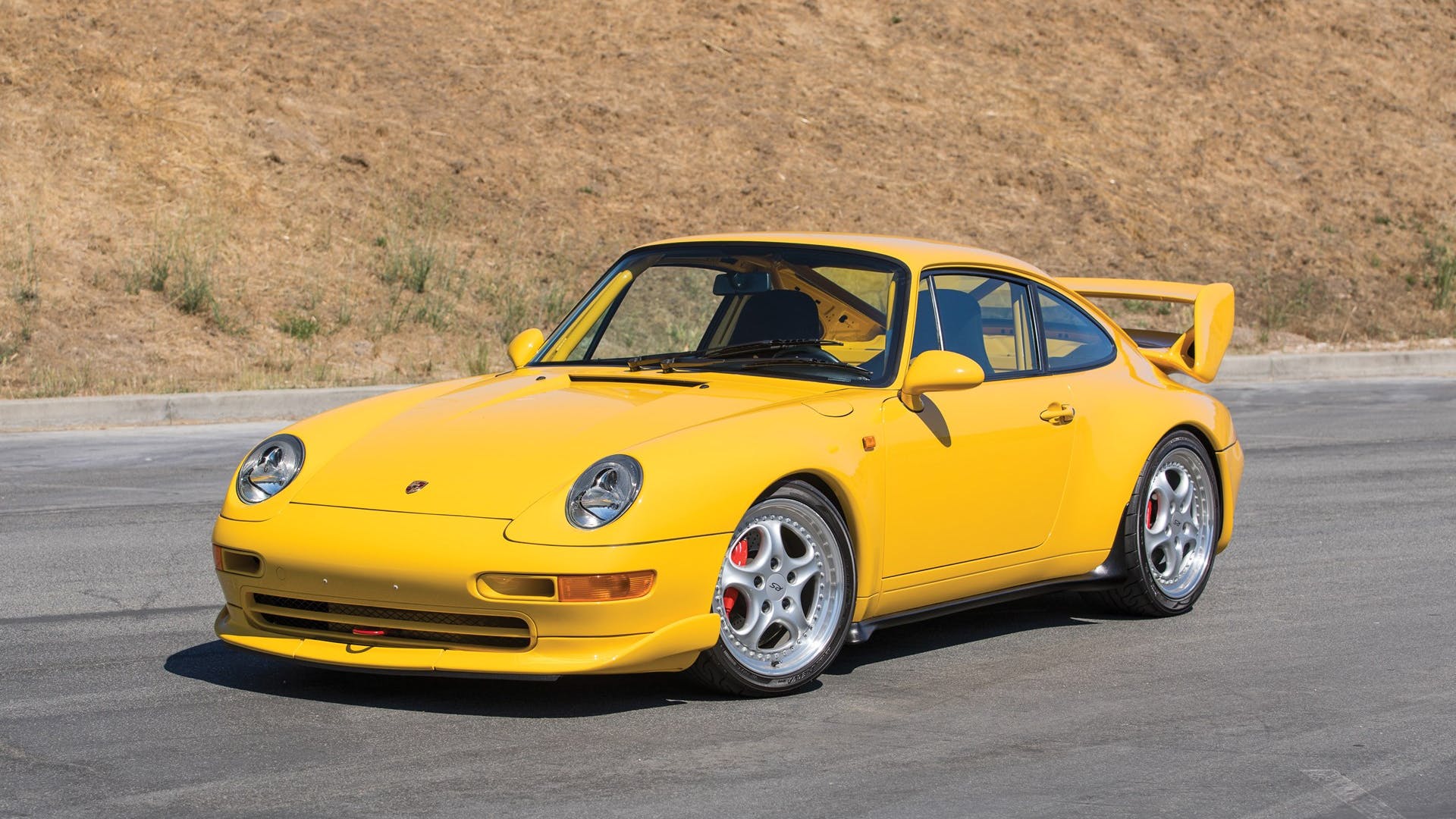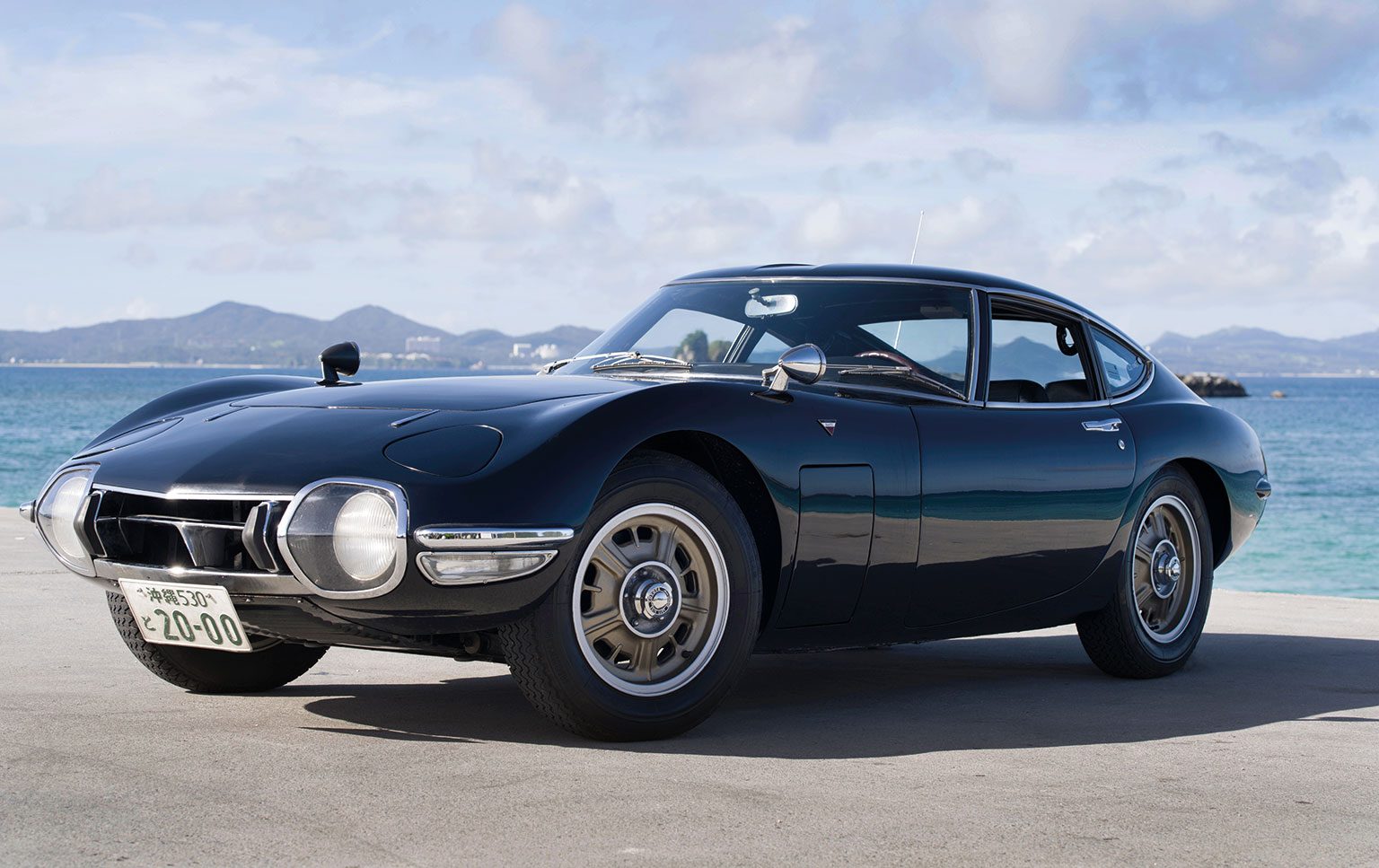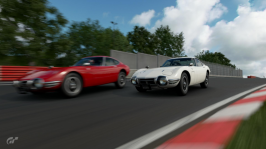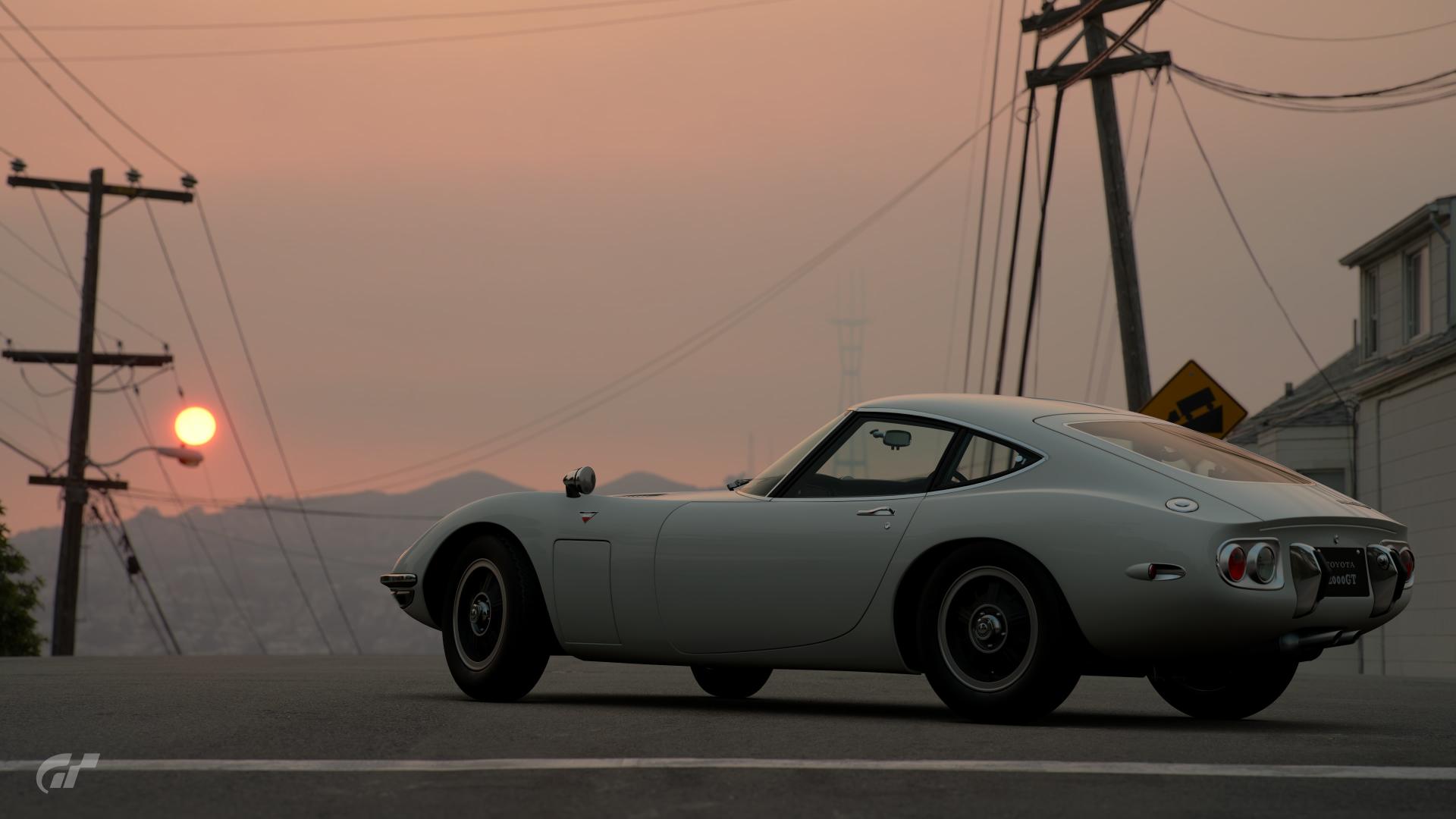You are using an out of date browser. It may not display this or other websites correctly.
You should upgrade or use an alternative browser.
You should upgrade or use an alternative browser.
Car of the Week 228: COTY GTS Finale
- Thread starter Racer283
- 3,110 comments
- 669,531 views
- 677

- Golden
- racer2833
I thought this car was selected in the past. Maaaannn, I would have been all over this as a choice. All three Kei cars, matter of factly.
A few weeks ago I chose the Daihatsu Copen VGT but we haven't done the '02 Copen.
- 48,719

- Australia
Ahh, that's what it was. 👍A few weeks ago I chose the Daihatsu Copen VGT but we haven't done the '02 Copen.
- 6,520

- Hanover/Germany
- alexpkas
GTS Tsukuba hot lap + direct comparison with direct competitor STOCK Daihatsu Copen '02
What is there to say? It's a little quircky Japanese FF machine. And this is exactly how it feels while driven.
Driven stock on hard sport tyres without any driving aids, except ABS. First lap in third person view, second one in cockpit view, third one in bumper view, fourth one in hood view and fifth one in cinematic replay view. All driven laps are the same lap.
Verdict: Neutral.
What is there to say? It's a little quircky Japanese FF machine. And this is exactly how it feels while driven.
Driven stock on hard sport tyres without any driving aids, except ABS. First lap in third person view, second one in cockpit view, third one in bumper view, fourth one in hood view and fifth one in cinematic replay view. All driven laps are the same lap.
Verdict: Neutral.
Last edited:
- 165
- Rob_on_Drums
The little Daihatsu made for some good races.
- 701

- United States
- AgentBlackDog
Daihatsu Copen @ Red Bull Ring (Short Track) & Tsukuba Circuit
- 1,546

- Singapore
- XSquareStickIt
Debuting at a time when revered, instant classic Japanese sports cars were all being killed off by stricter emission laws, the Copen revs to a Supra surpassing 9,000rpm, is offered with a proper five speed stick, is smaller and lighter than an MR2, and will just as willingly take its top off as well. It features a 659cc Inline 4 engine under the bonnet, which is exceedingly rare for a Kei car, with most of them having only three cylinders. It looks cuter than a Pod, and even has a trunk to boot! And what if I were to tell you that such a car is made by Daihatsu, a company that's more known for their domestic and industrial vehicles than sporty cars?
Yet, does any of that really matter? Does the Copen's market share really care about any of that aside from its cute looks? It certainly didn't feel like Daihatsu cared that much about the driving dynamics of the Copen to me. Hailed by its in-game description as a "well engineered sporty machine", the suspension setup is a lot softer and sloppier than I'd have liked from a sports car. Despite being lightweight, the car pitches and rolls horribly, highlighting the Copen's lack of a locking differential up front under hard lateral loads, which means you'll be wheelspinning away power under hard cornering that you couldn't spin away at launch with even the crappiest of Comfort tyres. The excessive body movements combined with the front mass bias and short wheelbase makes the Copen Active Top become the Copen Hyperactive Rear, reliably gargling drivers senseless before spitting them out butt-backwards on Suzuka Turn 1 and Brock's Skyline at Bathurst, which are death traps that should only worry supercars with their engines in the middle and packing ten times the power of a Copen. Of the Copen's lineup, the Active Top isn't even the sportiest model; the soft, "detachable" top is 30 whole kilos (66lbs) lighter than the Active Top, with a lower cg. If you really want the sportiest Copen, you could've gotten the Ultimate Edition... or the Ultimate Edition S... or the Ultimate Edition S Memorial... or the Ultimate Edition II... or the 10th Anniversary Edition... or the GR Copen. Phew, did I get them all? No? I only get to have the Copen Active Top? Okay Kaz, you win this time... again.
Yes, the engine does rev unethically high for a piston engine, and yes, it is offered with a proper five speed stick to make the most of it. But just offering a manual gearbox and a tachometer that reads up to 10k doesn't make the Copen a sporty car, in the same way that wearing a Slayer T-Shirt doesn't make you a hardcore metal fan. The 659cc turbocharged Inline 4 is tuned for low to mid range torque, which means that it hyperventilates past 7k, so much so that short shifting it at around 6.8k results in better acceleration even with the mechanical disadvantage of a wide spread five speed ratio. Debuting at a time when six speeds have just become the norm for supercars and family sedans alike, the first gen Copen is unfortunately saddled with a five speed still, resulting in long gearing that causes the Copen to be dead on arrival at 140km/h (87mph) in fourth, where the speedo maxes out. On the track, I oftentimes find myself hanging limp with no torque and no correct gear to be in, what with its long ratios and the last 2k rpm being there just to make the tach look pretty. The choice of a 5 speed is doubly unfortunate because not only do you barely have to touch the stick on the track, but also because Kei cars are restricted by their class to have engines not exceeding 660cc in displacement, effectively putting a cap on their power output, and it's such a shame that the Copen can't have more mechanical advantage with its gearing and thus more wheel horsepower to compensate for this. On an uphill ramp into an expressway, you'll need to be using all of the throttle pedal and be in the correct gear to do anything more than hold onto a constant speed. Not to mention, the turbocharged engine sounds as willing and lively as a salaryman who's had to do 20 hours of overtime for no extra pay a week for a dead end company who'd replace him with a 1,300cc variant the moment he drops dead from overwork.
Sure, it's light, tiny, and never intimidating, which tends to lend itself to closely fought one make races and easy for beginners to pick up the basics of racing from. Taken on its own however, it's just... boring. The car's unmistakable and unique looks completely belie the nondescript dynamics of the car, because this car has no personality whatsoever when you're shroud in the car's bog-standard looking, cheap black plastic interior that looks to have come straight from the 90s. There isn't much going on from behind the wheel at all. Car isn't turning enough? Turn the steering wheel more, I guess? Launch? Put it in first and dump the clutch; there isn't even enough power on offer to wheelspin off the line. Throttle modulation? You mean, "flat out at all times unless I have to brake for the 5 sections of the 23 corner circuit that is Mount Panorama"? It's beginner friendly in the same way an alphabet book is toddler friendly: you'll want so much more so quickly, it's hard to not just get something else a little more challenging and involving as a first step if you can afford it.
I'll admit, all of my impressions of the car are formed on the default Sport Hard tyres, which we ran on race day. They feel grossly over specced for the car, which would explain why it felt so sloppy, with so much body movement. Back in GT6, someone coined a term for a problem common in that game: "overcylindered", for a car that sounds like it has more cylinders than it actually has. In Sport, I think I'll take inspiration from that and coin the term "Overtyred", or "Overtired", because that sounds a bit cooler. I think the Copen suffers from a very common problem in GTS, that being most road cars coming stock with Sport Hard tyres, from a Huayra to a Copen. In my estimation, I think Comfort Mediums suit the Copen best. It still won't wheelspin at launch, but at least it won't be pulling so much gs to upset its delicate suspension setup and break out the rear, and it's hard to notice its completely open diff when the body isn't rolling that much. Despite this however, I don't really think a simple tyre change will save the Copen from the obscurity in my mind. It's still horrendously boring, and ironically lacking in character dynamically to me. It just really needs an engine remap and final gear tweak to be something that I might actually pay attention to.
Despite all this however, I don't dislike the Copen. It's very hard to dislike a cheap, cute, unassuming, and reliable Kei car, especially from a marque such as Daihatsu, who I wish had more of a presence outside Japan. But I think that's where the charm of Daihatsu cars lie, because they just seem to retain that inexplicable Japanese quirk and personality that's nigh impossible to put into words, that other Japanese carmakers have lost in expanding their lineup globally. These things are hugely popular in Japan, and while I can't understand why, I can oddly believe its popularity, as a weeb who's on the verge of understanding Japanese culture, and I'm more than glad for its popularity. I guess a lot of the disappointment I felt this week stems from how I wanted more from Daihatsu, Toyota, and Gran Turismo. The Copen is one of the only two cars in Daihatsu's lineup in Sport, and the only one that is non-fictional. And it's such a shame, because the Gran Turismo series had always been that window to let the world take a peek into Japanese car culture, and Daihatsu was always a very prominent niche in that picture. I feel like I had perhaps subconsciously dumped all of that burden onto the Copen this week, and I had wanted something disproportionately big from its Kei car silhouette. I still wish we had a Midget, a Move, a Storia X4, and a Wake, among others. And perhaps that's too much broken hopes and dreams for one car and its 62HP (46kW) to carry on its McPherson Struts and Torsen Beams.
And besides, for all the demerits of the Copen I've listed, does any of it truly matter? Just like a modern Beetle and Mini Cooper, a Daihatsu Copen is the sort of car you take one look at and go, "aww!", and want one. It's not logical. It's the sort of car for young people who don't necessarily care about driving, practicality, or even bang for their buck, and just want to look fancy and stand out. These things will most likely be mostly specced with an automatic box and never be wrung past 4k rpm in the car's life. And that's fine. It's not a logical debate. You don't buy a car like this with your head. If you want it, if you like it, all the more power to you. It just does nothing for me personally.
I did have way too much fun doing this livery though, and I didn't even get to get it done in time for race day.
Yet, does any of that really matter? Does the Copen's market share really care about any of that aside from its cute looks? It certainly didn't feel like Daihatsu cared that much about the driving dynamics of the Copen to me. Hailed by its in-game description as a "well engineered sporty machine", the suspension setup is a lot softer and sloppier than I'd have liked from a sports car. Despite being lightweight, the car pitches and rolls horribly, highlighting the Copen's lack of a locking differential up front under hard lateral loads, which means you'll be wheelspinning away power under hard cornering that you couldn't spin away at launch with even the crappiest of Comfort tyres. The excessive body movements combined with the front mass bias and short wheelbase makes the Copen Active Top become the Copen Hyperactive Rear, reliably gargling drivers senseless before spitting them out butt-backwards on Suzuka Turn 1 and Brock's Skyline at Bathurst, which are death traps that should only worry supercars with their engines in the middle and packing ten times the power of a Copen. Of the Copen's lineup, the Active Top isn't even the sportiest model; the soft, "detachable" top is 30 whole kilos (66lbs) lighter than the Active Top, with a lower cg. If you really want the sportiest Copen, you could've gotten the Ultimate Edition... or the Ultimate Edition S... or the Ultimate Edition S Memorial... or the Ultimate Edition II... or the 10th Anniversary Edition... or the GR Copen. Phew, did I get them all? No? I only get to have the Copen Active Top? Okay Kaz, you win this time... again.
Yes, the engine does rev unethically high for a piston engine, and yes, it is offered with a proper five speed stick to make the most of it. But just offering a manual gearbox and a tachometer that reads up to 10k doesn't make the Copen a sporty car, in the same way that wearing a Slayer T-Shirt doesn't make you a hardcore metal fan. The 659cc turbocharged Inline 4 is tuned for low to mid range torque, which means that it hyperventilates past 7k, so much so that short shifting it at around 6.8k results in better acceleration even with the mechanical disadvantage of a wide spread five speed ratio. Debuting at a time when six speeds have just become the norm for supercars and family sedans alike, the first gen Copen is unfortunately saddled with a five speed still, resulting in long gearing that causes the Copen to be dead on arrival at 140km/h (87mph) in fourth, where the speedo maxes out. On the track, I oftentimes find myself hanging limp with no torque and no correct gear to be in, what with its long ratios and the last 2k rpm being there just to make the tach look pretty. The choice of a 5 speed is doubly unfortunate because not only do you barely have to touch the stick on the track, but also because Kei cars are restricted by their class to have engines not exceeding 660cc in displacement, effectively putting a cap on their power output, and it's such a shame that the Copen can't have more mechanical advantage with its gearing and thus more wheel horsepower to compensate for this. On an uphill ramp into an expressway, you'll need to be using all of the throttle pedal and be in the correct gear to do anything more than hold onto a constant speed. Not to mention, the turbocharged engine sounds as willing and lively as a salaryman who's had to do 20 hours of overtime for no extra pay a week for a dead end company who'd replace him with a 1,300cc variant the moment he drops dead from overwork.
Sure, it's light, tiny, and never intimidating, which tends to lend itself to closely fought one make races and easy for beginners to pick up the basics of racing from. Taken on its own however, it's just... boring. The car's unmistakable and unique looks completely belie the nondescript dynamics of the car, because this car has no personality whatsoever when you're shroud in the car's bog-standard looking, cheap black plastic interior that looks to have come straight from the 90s. There isn't much going on from behind the wheel at all. Car isn't turning enough? Turn the steering wheel more, I guess? Launch? Put it in first and dump the clutch; there isn't even enough power on offer to wheelspin off the line. Throttle modulation? You mean, "flat out at all times unless I have to brake for the 5 sections of the 23 corner circuit that is Mount Panorama"? It's beginner friendly in the same way an alphabet book is toddler friendly: you'll want so much more so quickly, it's hard to not just get something else a little more challenging and involving as a first step if you can afford it.
I'll admit, all of my impressions of the car are formed on the default Sport Hard tyres, which we ran on race day. They feel grossly over specced for the car, which would explain why it felt so sloppy, with so much body movement. Back in GT6, someone coined a term for a problem common in that game: "overcylindered", for a car that sounds like it has more cylinders than it actually has. In Sport, I think I'll take inspiration from that and coin the term "Overtyred", or "Overtired", because that sounds a bit cooler. I think the Copen suffers from a very common problem in GTS, that being most road cars coming stock with Sport Hard tyres, from a Huayra to a Copen. In my estimation, I think Comfort Mediums suit the Copen best. It still won't wheelspin at launch, but at least it won't be pulling so much gs to upset its delicate suspension setup and break out the rear, and it's hard to notice its completely open diff when the body isn't rolling that much. Despite this however, I don't really think a simple tyre change will save the Copen from the obscurity in my mind. It's still horrendously boring, and ironically lacking in character dynamically to me. It just really needs an engine remap and final gear tweak to be something that I might actually pay attention to.
Despite all this however, I don't dislike the Copen. It's very hard to dislike a cheap, cute, unassuming, and reliable Kei car, especially from a marque such as Daihatsu, who I wish had more of a presence outside Japan. But I think that's where the charm of Daihatsu cars lie, because they just seem to retain that inexplicable Japanese quirk and personality that's nigh impossible to put into words, that other Japanese carmakers have lost in expanding their lineup globally. These things are hugely popular in Japan, and while I can't understand why, I can oddly believe its popularity, as a weeb who's on the verge of understanding Japanese culture, and I'm more than glad for its popularity. I guess a lot of the disappointment I felt this week stems from how I wanted more from Daihatsu, Toyota, and Gran Turismo. The Copen is one of the only two cars in Daihatsu's lineup in Sport, and the only one that is non-fictional. And it's such a shame, because the Gran Turismo series had always been that window to let the world take a peek into Japanese car culture, and Daihatsu was always a very prominent niche in that picture. I feel like I had perhaps subconsciously dumped all of that burden onto the Copen this week, and I had wanted something disproportionately big from its Kei car silhouette. I still wish we had a Midget, a Move, a Storia X4, and a Wake, among others. And perhaps that's too much broken hopes and dreams for one car and its 62HP (46kW) to carry on its McPherson Struts and Torsen Beams.
And besides, for all the demerits of the Copen I've listed, does any of it truly matter? Just like a modern Beetle and Mini Cooper, a Daihatsu Copen is the sort of car you take one look at and go, "aww!", and want one. It's not logical. It's the sort of car for young people who don't necessarily care about driving, practicality, or even bang for their buck, and just want to look fancy and stand out. These things will most likely be mostly specced with an automatic box and never be wrung past 4k rpm in the car's life. And that's fine. It's not a logical debate. You don't buy a car like this with your head. If you want it, if you like it, all the more power to you. It just does nothing for me personally.
I did have way too much fun doing this livery though, and I didn't even get to get it done in time for race day.
- 1,546

- Singapore
- XSquareStickIt
Of course! You and everyone else are welcome to join us. The more the merrier! The races aren't a requirement at all, and there isn't a form to fill to join. Just start writing and post! 

jrbabbitt
Premium
- 2,247

- Charleston, SC
- TCR_JimyBee
Thank you and will do my best...Of course! You and everyone else are welcome to join us. The more the merrier! The races aren't a requirement at all, and there isn't a form to fill to join. Just start writing and post!
A question, is there a specific track to run for the review?
- 2,817

- Lincoln
- Victory_Reign93
- Linthium Reign
Nope, It’s a blank canvas in how and where you do your write ups.Thank you and will do my best...
A question, is there a specific track to run for the review?

Feel like getting some action shots at Le Mans? go for it.
Want to kick up some dirt in your photos? go right ahead.
The only limit to your reviews is your imagination..
And the websites AUP.

jrbabbitt
Premium
- 2,247

- Charleston, SC
- TCR_JimyBee
Nope, It’s a blank canvas in how and where you do your write ups.
Feel like getting some action shots at Le Mans? go for it.
Want to kick up some dirt in your photos? go right ahead.
The only limit to your reviews is your imagination..
And the websites AUP.
Ok thanks
- 6,520

- Hanover/Germany
- alexpkas
GTS Nordschleife hot lap STOCK Porsche 911 Carrera RS CS 993 '95: 07.52.050
At first I was really disappointed. It felt far too "floaty". But once I got the hang out of it, it was a very "intuitive" and "fluid" experience and drive. Wonderful car with great desing, great sound and great handling. Love it.
Driven stock on hard sport tyres without any driving aids, except ABS. First lap in third person view, second one in cockpit view and third one in cinematic replay view. All driven laps are the same lap.
With its driven time, it is the 60th fastest car of all road legal cars. Its closest rivals are the Nissan Skyline GT-R V-spec II Nür (R34) '02 with a 07.53.002 on the 61st place and the Ford Mutang GT '15 with a 07.49.948 on the 59th place. It can reach a top speed of 284 km/h=176mp/h in the game (real life top speed being 275 km/h=171 mp/h), securing itself the 68th place top speed wise of all road legal cars, while its closest top speed rivals are the Mitsubishi GTO Twin Turbo '91 and the Alpine A110 Premier Edition '17, both with 281km/h=175mp/h sharing the 70th-69th places and the Plymouth XNR Ghia Roadster '60 with 285km/h=177mp/h on the 67th place.
Nordschleife comparison with closest rivals:
Bonus: Direct side by side comparison on Tsukuba with the 911 Turbo 930. This video should release in a few months, so I'll release it here for the week of COTW and block it again after that. Just for you guys.
 Please tell me, if you can't see it.
Please tell me, if you can't see it.
Verdict: Can't REALLY call it a sleeper. Its performance is as expected, though still very impressive obviously. So I guess it's a neutral from me, with a slight tendency to sleeper status.
At first I was really disappointed. It felt far too "floaty". But once I got the hang out of it, it was a very "intuitive" and "fluid" experience and drive. Wonderful car with great desing, great sound and great handling. Love it.
Driven stock on hard sport tyres without any driving aids, except ABS. First lap in third person view, second one in cockpit view and third one in cinematic replay view. All driven laps are the same lap.
With its driven time, it is the 60th fastest car of all road legal cars. Its closest rivals are the Nissan Skyline GT-R V-spec II Nür (R34) '02 with a 07.53.002 on the 61st place and the Ford Mutang GT '15 with a 07.49.948 on the 59th place. It can reach a top speed of 284 km/h=176mp/h in the game (real life top speed being 275 km/h=171 mp/h), securing itself the 68th place top speed wise of all road legal cars, while its closest top speed rivals are the Mitsubishi GTO Twin Turbo '91 and the Alpine A110 Premier Edition '17, both with 281km/h=175mp/h sharing the 70th-69th places and the Plymouth XNR Ghia Roadster '60 with 285km/h=177mp/h on the 67th place.
Nordschleife comparison with closest rivals:
Bonus: Direct side by side comparison on Tsukuba with the 911 Turbo 930. This video should release in a few months, so I'll release it here for the week of COTW and block it again after that. Just for you guys.

 Please tell me, if you can't see it.
Please tell me, if you can't see it. Verdict: Can't REALLY call it a sleeper. Its performance is as expected, though still very impressive obviously. So I guess it's a neutral from me, with a slight tendency to sleeper status.

Last edited:
- 5,577

- Manila, PH
- TakuKanonji22
Ah.... the Carrera RS. Quite an interesting choice for PD to represent a 993 in the game. We could have had a GT2, or a 993 Turbo to at least give us a taste of a 4WD 911. Maybe they want to stick to the driver-focused 911s.

The color choices are a godsend. The best one so far for me is the Riviera Blue. This light blue shade is fits perfectly in all 911s, in my opinion.

Though I repainted it in Voodoo Blue.
This 911 also bears the final iteration of the "Carrera RS" name. It's a swansong, perhaps, knowing full well that everything will change when the 996 took over the reins. The Carrera RS has no holds barred approach to performance. Everything was stripped out, but hey, at least we get a roll cage matching the body color. No aircon? Pfft. Then don't drive it in summer.... unless you don't mind sweating on a track day.

Performance? What to expect? It's a 911! Though being the last of the air-cooled era, and has the best improvements applied to a chassis that was basically formed way back in 1963, you'd still feel the quirks of an old-school 911. It can be floaty, and has widow-maker tendencies, but once you get the hang of it or do some adjustments, it can be a proper N300 class Porsche, without the need of detuning the 996 GT3 (which is obviously OP in N300) and give a fair play. The acceleration does not feel like it's running on 300 horsepower thanks to the engine slung all the way back, giving the rear tires the proper squat when making pulls. It can outclass the JDMs of the same class in almost all aspects, save for stability, since an R32 GT-R or any 4WD will have an edge.
What about in its max tune? Well, all I can say is that it's at least more bearable to drive than the equally tuned 930. Again, don't forget the widow-maker quirks.
All-in-all, it's a welcome addition, especially that the 993 is one of the most sought-after 911s, and at least we can enjoy its knife edge performance virtually in Gran Turismo Sport.
The color choices are a godsend. The best one so far for me is the Riviera Blue. This light blue shade is fits perfectly in all 911s, in my opinion.
Though I repainted it in Voodoo Blue.

This 911 also bears the final iteration of the "Carrera RS" name. It's a swansong, perhaps, knowing full well that everything will change when the 996 took over the reins. The Carrera RS has no holds barred approach to performance. Everything was stripped out, but hey, at least we get a roll cage matching the body color. No aircon? Pfft. Then don't drive it in summer.... unless you don't mind sweating on a track day.
Performance? What to expect? It's a 911! Though being the last of the air-cooled era, and has the best improvements applied to a chassis that was basically formed way back in 1963, you'd still feel the quirks of an old-school 911. It can be floaty, and has widow-maker tendencies, but once you get the hang of it or do some adjustments, it can be a proper N300 class Porsche, without the need of detuning the 996 GT3 (which is obviously OP in N300) and give a fair play. The acceleration does not feel like it's running on 300 horsepower thanks to the engine slung all the way back, giving the rear tires the proper squat when making pulls. It can outclass the JDMs of the same class in almost all aspects, save for stability, since an R32 GT-R or any 4WD will have an edge.
What about in its max tune? Well, all I can say is that it's at least more bearable to drive than the equally tuned 930. Again, don't forget the widow-maker quirks.
All-in-all, it's a welcome addition, especially that the 993 is one of the most sought-after 911s, and at least we can enjoy its knife edge performance virtually in Gran Turismo Sport.
Last edited:
- 6,520

- Hanover/Germany
- alexpkas
Ah.... the Carrera RS. Quite an interesting choice for PD to represent a 993 in the game. We could have had a GT2, or a 993 Turbo to at least give us a taste of a 4WD 911. Maybe they want to stick to the driver-focused 911s.
View attachment 1004104
The color choices are a godsend. The best one so far for me is the Riviera Blue. This light blue shade is fits perfectly in all 911s, in my opinion.
View attachment 1004105
Though I repainted it in Voodoo Blue.
This 911 also bears the final iteration of the "Carrera RS" name. It's a swansong, perhaps, knowing full well that everything will change when the 996 took over the reins. The Carrera RS has no holds barred approach to performance. Everything was stripped out, but hey, at least we get a roll cage matching the body color. No aircon? Pfft. Then don't drive it in summer.... unless you don't mind sweating on a track day.
View attachment 1004106
Performance? What to expect? It's a 911! Though being the last of the air-cooled era, and has the best improvements applied to a chassis that was basically formed way back in 1963, you'd still feel the quirks of an old-school 911. It can be floaty, and has widow-maker tendencies, but once you get the hang of it or do some adjustments, it can be a proper N300 class Porsche, without the need of detuning the 996 GT3 (which is obviously OP in N300) and give a fair play. The acceleration does not feel like it's running on 300 horsepower thanks to the engine slung all the way back, giving the rear tires the proper squat when making pulls. It can outclass the JDMs of the same class in almost all aspects, save for stability, since an R32 GT-R or any 4WD will have an edge.
What about in its max tune? Well, all I can say is that it's at least more bearable to drive than the equally tuned 930. Again, don't forget the widow-maker quirks.
All-in-all, it's a welcome addition, especially that the 993 is one of the most sought-after 911s, and at least we can enjoy its knife edge performance virtually in Gran Turismo Sport.
It's definitely a BEATER.
You surely mean it's a sleeper, 'cause beater=bad as in what a beaten piece of garbage, sleeper=good as in didn't expect it to be THIS good. Don't worry, I made the same mistake.

TonyJZX
(Banned)
- 3,945

- Australia
God knows I love Porsches and especially 911s but I find the 993 CS as depicted in GT SPort to be an utterly tiring and unrewarding car to drive.
I have won in this car but its so tough... its like the Chinese plate spinner... you have so many dishes spinning on a stick.... sure you can keep up the charade but its easier in say a Corvette.
The 993 has a LOT of vices.... it does not like contact with kerbs and grass... it does not suffer tyre wear very well... ie. performance will degrade and be almost dangerous. It does not like you braking in non straight lines. It does not like you being too cavalier exiting out a corner.
You need to be very accurate in placing the car. You need to use all the track and keep the car in its performance envelope.
It has that Porsche PD characteristic where the steering feels slightly too sensitive so you steer HARDER and then the back end reacts and the car is out of shape. I think it feels like either end of the car reacts badly if the opposite end gets out of shape. If your entry is good you exit should be good.
If you go in bad, you come out badder!
Any contact with other cars means you get pitted as your car is solely dependent on every tyre maintaining optimum contact patch... or ELSE. I think this also manifests itself in odd behaviour on road camber ie. one tyre losts traction then the whole car reacts.
The engine is... ok.... it does have a slight mid range hump which is helpful... but its also helpful in roasting your back tyres out of corners.
To be fair the 996 as displays some of this and even the 997 has some odd rear engine character.
Its such a gorgeous car though. btw. the 930 turbo is even worse.
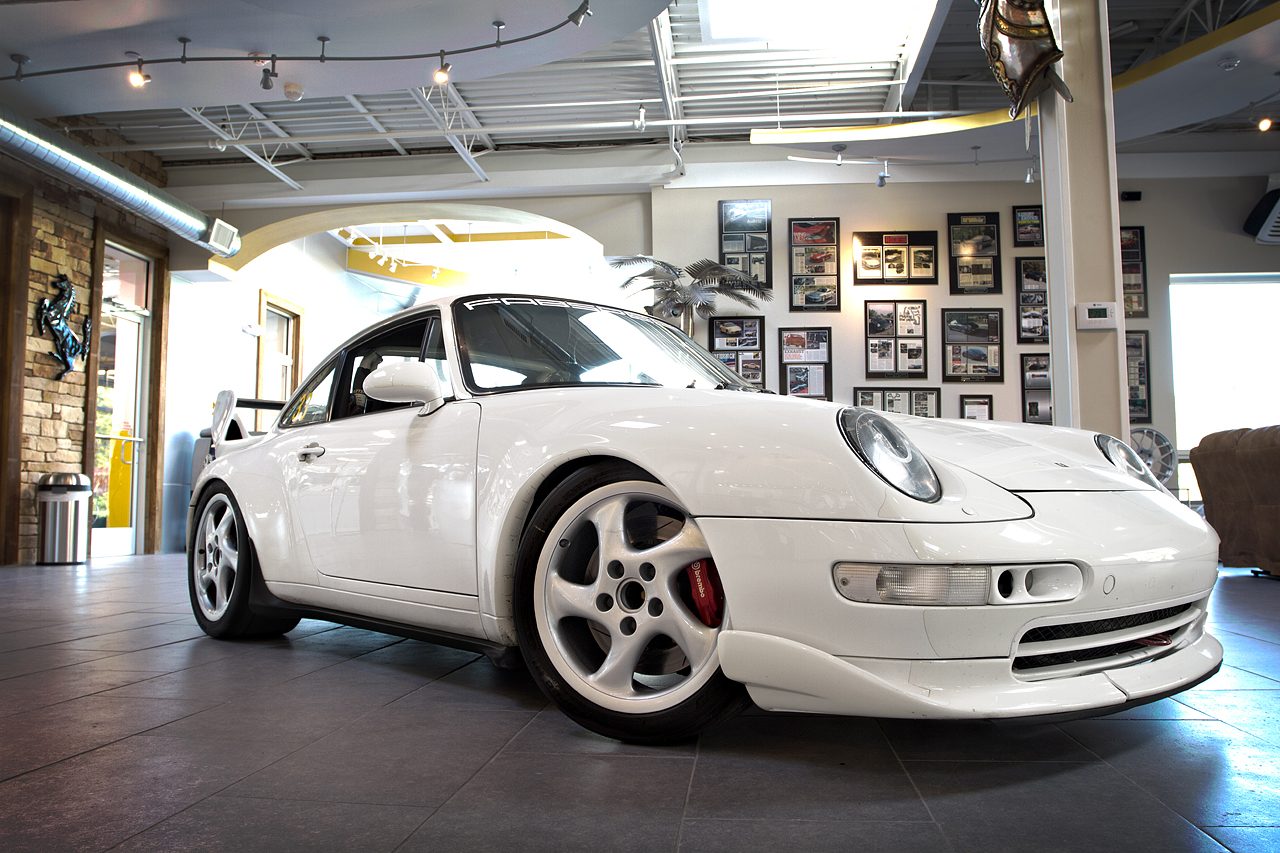
I have won in this car but its so tough... its like the Chinese plate spinner... you have so many dishes spinning on a stick.... sure you can keep up the charade but its easier in say a Corvette.
The 993 has a LOT of vices.... it does not like contact with kerbs and grass... it does not suffer tyre wear very well... ie. performance will degrade and be almost dangerous. It does not like you braking in non straight lines. It does not like you being too cavalier exiting out a corner.
You need to be very accurate in placing the car. You need to use all the track and keep the car in its performance envelope.
It has that Porsche PD characteristic where the steering feels slightly too sensitive so you steer HARDER and then the back end reacts and the car is out of shape. I think it feels like either end of the car reacts badly if the opposite end gets out of shape. If your entry is good you exit should be good.
If you go in bad, you come out badder!
Any contact with other cars means you get pitted as your car is solely dependent on every tyre maintaining optimum contact patch... or ELSE. I think this also manifests itself in odd behaviour on road camber ie. one tyre losts traction then the whole car reacts.
The engine is... ok.... it does have a slight mid range hump which is helpful... but its also helpful in roasting your back tyres out of corners.
To be fair the 996 as displays some of this and even the 997 has some odd rear engine character.
Its such a gorgeous car though. btw. the 930 turbo is even worse.

- 701

- United States
- AgentBlackDog
The 911 Carrera RS CS seems to fare decently against some cars under 300 BHP. Some careful throttle control and steering is needed.
Verdict: Neutral.
*These tests were done with sports medium tires with traction control disabled. No car was modified.



The Test Drive:
Verdict: Neutral.
*These tests were done with sports medium tires with traction control disabled. No car was modified.
The Test Drive:
Last edited:
- 2,426

- South Auckland, New Zealand
- Nismonath5
So, good news and bad news...
Good news is Hooncorp now has a fully operational, functioning work shop and there's A LOT of racing planned for the next few months..
Bad news is, part of the deal with having this workshop is that we now work for the Euro car dealer across from us, and doubling that with the way time zones are, it's unlikely I'll be able to make many of the races at the moment
I'll still try chip in when I can, I know I've been all but silent on here recently but the last couple of weeks have literally been cleaning this place out and getting it up and running. Hopefully soon I'll be able to get some pics and reviews up. I do quite like the Clubsport
Good news is Hooncorp now has a fully operational, functioning work shop and there's A LOT of racing planned for the next few months..
Bad news is, part of the deal with having this workshop is that we now work for the Euro car dealer across from us, and doubling that with the way time zones are, it's unlikely I'll be able to make many of the races at the moment

I'll still try chip in when I can, I know I've been all but silent on here recently but the last couple of weeks have literally been cleaning this place out and getting it up and running. Hopefully soon I'll be able to get some pics and reviews up. I do quite like the Clubsport

- 677

- Golden
- racer2833
Last edited:
jrbabbitt
Premium
- 2,247

- Charleston, SC
- TCR_JimyBee
Toyota 2000GT
The Toyota 2000GT is a limited-production front mid-engine, rear-wheel-drive, two-door, two-seat sports car/grand tourer designed by Toyota in collaboration with Yamaha. First displayed to the public at the Tokyo Motor Show in 1965, the 2000GT was manufactured under contract by Yamaha between 1967 and 1970. A halo car for the automaker, in Japan it was exclusive to Toyota's Japanese retail sales channel called Toyota Store. Today, the 2000GT is seen as the first seriously collectible Japanese car and its first supercar. Examples of the 2000GT have sold at auction for as much as US$1,200,000.
I had first seen one of these at a car show in California and the first thing I recall on is how small this car was, I stand 5’7 and I had to move the seat back to be comfortable with the pedal placement.
Now on to the main part of this COTW report, I had taken my 2000GT and restored it to stock condition for this test. As it come to you initially with Sport Hard rubber on all fours, brake balance at 0, TCM at 3, all suspension setting were defaulted as was the LSD and the transmission set to the default “stock” condition. I had wanted to change the tires to soft and adjust the brake balance for control I did not to keep it “stock”.
I use the DS4 controller and quite good with it also, I drive with an automatic transmission (not coordinated enough for manual on controller) and seem to do well with this also.
I usually do my test drives on my favorite and well driven Nurburgring track. As mentioned above initially I wanted to adjust the brake balance to -2 and put on the sport soft tires for better control overall, I do find there is a bit of understeer initially in curves at higher speed and sometimes a small amount of oversteer on exits of curves when you lift up off the accelerator, easily corrected with brake balance and small adjustment to the rear LSD if needed.

I made a “one-make” race on the same track to see how it can handle a race of its peers, it did not struggle nor was it easy to get a win. The 2000GT has a high narrow power band and when the revs get down it tends to bog down and take a small amount of time to get back up to speed.
Overall the Toyota 2000GT is a wonderful driving car but lacks in the higher speeds that are found in the nostalgic races, with proper tuning and power additions it can give it a go and perform quite well. In BoP races it will do quite well and is very nimble and drivable.
The Toyota 2000GT is a limited-production front mid-engine, rear-wheel-drive, two-door, two-seat sports car/grand tourer designed by Toyota in collaboration with Yamaha. First displayed to the public at the Tokyo Motor Show in 1965, the 2000GT was manufactured under contract by Yamaha between 1967 and 1970. A halo car for the automaker, in Japan it was exclusive to Toyota's Japanese retail sales channel called Toyota Store. Today, the 2000GT is seen as the first seriously collectible Japanese car and its first supercar. Examples of the 2000GT have sold at auction for as much as US$1,200,000.
I had first seen one of these at a car show in California and the first thing I recall on is how small this car was, I stand 5’7 and I had to move the seat back to be comfortable with the pedal placement.
Now on to the main part of this COTW report, I had taken my 2000GT and restored it to stock condition for this test. As it come to you initially with Sport Hard rubber on all fours, brake balance at 0, TCM at 3, all suspension setting were defaulted as was the LSD and the transmission set to the default “stock” condition. I had wanted to change the tires to soft and adjust the brake balance for control I did not to keep it “stock”.
I use the DS4 controller and quite good with it also, I drive with an automatic transmission (not coordinated enough for manual on controller) and seem to do well with this also.
I usually do my test drives on my favorite and well driven Nurburgring track. As mentioned above initially I wanted to adjust the brake balance to -2 and put on the sport soft tires for better control overall, I do find there is a bit of understeer initially in curves at higher speed and sometimes a small amount of oversteer on exits of curves when you lift up off the accelerator, easily corrected with brake balance and small adjustment to the rear LSD if needed.
I made a “one-make” race on the same track to see how it can handle a race of its peers, it did not struggle nor was it easy to get a win. The 2000GT has a high narrow power band and when the revs get down it tends to bog down and take a small amount of time to get back up to speed.
Overall the Toyota 2000GT is a wonderful driving car but lacks in the higher speeds that are found in the nostalgic races, with proper tuning and power additions it can give it a go and perform quite well. In BoP races it will do quite well and is very nimble and drivable.
Attachments
- 165
- Rob_on_Drums
Fun story. When the movie producers picked the perfect car for James Bond to drive in Japan in “Dr. No”, they chose this Toyota. However, when Sean Connery arrived, they realized he didn’t fit in the car. So, Toyota cut off the roof and made it to a convertible just for the film.
jrbabbitt
Premium
- 2,247

- Charleston, SC
- TCR_JimyBee
Yes and only two were made, one is at the Petersen Automotive museum in Los Angeles and the other lives at the Toyota MuseumFun story. When the movie producers picked the perfect car for James Bond to drive in Japan in “Dr. No”, they chose this Toyota. However, when Sean Connery arrived, they realized he didn’t fit in the car. So, Toyota cut off the roof and made it to a convertible just for the film.
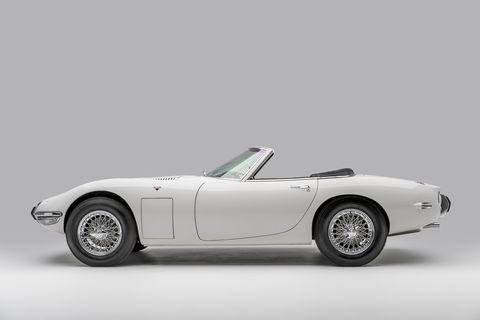
Such beautiful wire wheels...
Last edited:
jrbabbitt
Premium
- 2,247

- Charleston, SC
- TCR_JimyBee
From the 1967 June Issue of Road & Track
If the Toyota 2000GT is an impressive mechanical design on paper, and even if it looks pretty in the pictures, nothing quite prepares you for your first look at it. The pictures just don't do justice to it. The most striking thing not evident in the photos is the lowness of the thing, and it's amazing how a scale factor like that can modify the whole visual impression of a car. We've seen many cars that we thought would look better if they were scaled down; the 2000GT is one that is smaller than it looks in print.
Styling, however, isn't the car's strongest point—and according to the Toyota people it wasn't intended to be. Our styling experts found detail styling flaws and some unfortunate surface development; but none denied that the overall impression of the car is one of excitement and purpose. Confirmation of the latter conclusion is easy to obtain: one of our staff commented that his drive home to lunch one day was the first occasion on which he was ever followed by cars. He picked up 2 VWs, an MGB, 2 Ford pickups and one policeman in two 10-minute runs!
The designers, as pointed out in the preceding analysis, did all they could to make getting in or out easy. But let's face it; this is a 45.7-in.-high car. You want a low car, you settle for contortions. Once in you know it was worth the trouble: surrounded by impressive instrumentation, much padding and all that beautiful rosewood, and sitting so low you know you're in something special, you are sure it has to be good. The seat is adjustable for rake, but the more it's raked the more its fore-and-aft travel is limited by the structural member behind it. If you are of average American male height, you'll find yourself in a semi-reclining, but very comfortable, position; if you're the 99th man you may find it nearly impossible to fit yourself in.
A key-turn starts the engine, and it catches smoothly from the starter like a good "six" should. The engine likes to idle at 1200 rpm or so, but there is no mechanical clatter to be heard either at idle or out on the road. The soundproofing has really done a job here—but listening to the unit with the hood open (which also happens to be a delightful visual experience) reveals that the engine is mechanically quiet to begin with, particularly for one with chain-driven double over head cams.
The engine has no trouble getting the car going smoothly; 1st gear is perhaps a bit too great a reduction, and it's a big step from there to 2nd. The clutch engages smoothly and takes the abuse of repeated acceleration runs without any kind of protest, and it's a smooth, strong climb to peak engine speed—with the exception that the engine begins to miss at 7000 rpm, just past the yellow line. For some unknown reason, in 1st gear the missing would commence at about 6300 rpm; hence the rather early 1-2 shift point on the acceleration graph. The engine will pull smoothly but not strongly from idling speed in 4th gear and from about 1500 in 5th, but closed throttle at these speeds produces considerable bucking, which in turn induces gear rattle in the gearbox. The Toyota people assure us that this will be rectified by the time cars are offered for sale; our test car was the first production model to reach America and will not be sold.
The gearbox is quiet and generally smooth, and the ratios seem appropriate for the car with the possible exception of 1st; but shift efforts were so high on our test car that the engineering editor got a callus on his ring finger, and 2nd gear synchromesh was ineffective for speed shifts. Fifth gear emits a slight whine, not enough to bother any of us but reminding us that it is an indirect ratio. There was no noise of any kind from the final drive—some kind of feat in a car with that member mounted on the frame.
As a final note on the power unit, the exhaust note is beautiful, with a strong "rap" at 2800 rpm which intrudes on the low noise level and which Toyota plans to eliminate. It was great fun to go rapping past little old ladies in E-types, but it's probably wise of Toyota engineers to eliminate this, for it might get tiresome day in and day out.
When it comes to ride and handling, nobody in his right mind could need or want more in a road vehicle than the 2000GT has to offer. The low center of gravity and fairly high roll axis have allowed soft springs to be used without excessive roll, and this combined with good suspension travel available makes for a wonderful combination of ride and roadholding. We were skeptical at first about driving across city dips at undiminished speeds in such a low car, but we soon found that we could traverse these and other severe irregularities with verve and comfort. The body structure is rigid and quiet in general, but our test car had one bad rattle somewhere underneath, and its tailgate could not be adjusted to close tightly enough.
Cornering with the 2000GT is so easy and flat as to make the usual vigorous driving on smooth, winding roads almost dull. To get near its limits requires more nerve than most drivers have, and bumpy roads affect it so little as not to matter. Steering is light and quick with an overall ratio of 15.0:1; steering characteristics are neutral under all normal conditions. The mild rear weight bias (52%) is just enough to help out a little in case one wants to induce oversteer with the throttle. With the standard 165-15 Dunlop SP-41 tires, ab solute cornering power isn't spectacular—but, to repeat ourselves, it's all anyone needs on the road.
The excellence of the rear suspension made itself known on test day at the drag strip, too. We tried various engine speeds before the usual clutch-dump for getting off the line and found that regardless of technique the rear wheels simply spin, evenly and smoothly. As it turned out. we got best times by using 5000 rpm and engaging the clutch quickly but not brutally. An odd quirk, however, was that the car steered slightly to the right on even slight acceleration.
The 2000's brakes are equally impressive. Not only did they survive our 6-stop fade test with no measurable fade, but they also managed to pull speed down at the rate of 27 ft/sec/sec (0.84 g) from 80 mph. steadily and with no tendency toward wheel locking. The handbrake, an "L" handle coming out of the dash, held the car on our 30% test hill—a mild surprise because it works directly on the rear discs. Pedal efforts with the standard vacuum boost aren't unreasonably low, either. One criticism here: application of the brakes in reversing brings out an embarrassing squeal.
If the 2000 GT is an impressive car to drive, it's an equally impressive one in which to sit or ride—or simply to admire. One staff member could describe his feelings about the interior with only one word: overwhelming. The seats cradle you nicely and nobody who could actually fit into the car complained about them. But our Comfort Index ratings indicate that not everyone can fit. All interior details are in good taste and the finish of our car's interior was of the quality you'd expect in a luxurious GT. The steering wheel is adjust able telescopically, but in our test car pushing the wheel all the way in sounded the horn!—obviously a minor wiring problem. We don't know if the steering column of the test car would meet the new safety standards, however; but if not it will be changed by the time cars are for sale here.
The instruments are all white-on-black, well marked and steady. Main controls, including a manual choke and separate throttle, are in a row on a recessed panel below the two main dials; others, including heating, radio, antenna, fog lights and headlight retraction, are in the center console and still quite handy for the driver. Besides the normal electrically wound clock there is a rally clock with stop-start and reset buttons. The heating/ventilating system is similar to American practice with controls for fresh air, temperature, direction (feet or windshield) and 3-speed blower on the console. Swiveling nozzles are provided for the floor area and chin-level vents, the latter taking in fresh air independently of the heater. Directional signals are operated by a toggle switch on the dash and are, oddly enough, non-canceling.
Nothing fitted to our test car was an optional extra. The AM radio is standard and rather unusual: it has automatic signal seeking which is set into action by pushing the right- hand (volume) knob, after which push it proceeds from station to station, pausing about 10 sec at each one to give you a chance to decide whether you like the station or not. A second push on the knob stops the seeking. The radio is turned on by an upward push on the toggle switch that raises and lowers the electrically powered antenna at the rear. The left- hand button tunes by turning and adjusts tone by pushing— there are only two tones settings, strangely enough. Among other interior touches are an ashtray and lighter in each door.
Vision outward is good through the heavily wrapped-around windshield and ventless side windows; there was considerable distortion in the windshield of our test car, though, and instrument reflections in its upper half are bothersome at night. Vision to the rear is restricted; the combination of high rear spring towers (reducing the side windows) and a tailgate (reducing the rear window) conspire to claustrophobize, and the only solution is to use the standard fender mirrors.
Storage space is limited. The data panel shows 4.8 cu ft, and that figure is predicated on loading the space to the roof, eliminating rear vision through the rear window. The dash glove box is pretty large, and there's an additional small compartment in the rear floor. But the fact is that the two tourists in the Toyota will have to travel light.
Finish on the outside of our test car was just as pleasing as the interior. The true red paint job was excellent and all trim fit exactly as it should. Three nice touches on the exterior are the matt-finished inboard cases of the fender mirrors, the "aerodynamic" windshield wipers and the flat-finish window surrounds. The front end of the car seems to be a mass of re movable panels: there are four of them in all, the two top side ones coming off to give access to the release mechanism for the two side ones!
Miscellaneous observations: the car has Ford-type reversible keys (there is no upside down); the gas cap locks; bumper protection is minimal; nice tool kit; heated rear window comes on with heater blower switch; wipers leave blind spot on side opposite driver; no wind noise with windows closed but some buffeting with them open.
In conclusion, the Toyota 2000 GT is one of the most ex citing and enjoyable cars we've driven. At its price (estimated for now) it will be squared off with the Porsche 911-911S—and it's a worthy competitor for that excellent motor car as well as offering a combination of qualities distinctly its own. It's not as fast as either 911, but it is more luxurious, and its handling is of the front-engine variety. If you have $6000-plus to spend and like a judicious blend of sport and refinement, the Toyota 2000 GT will merit your serious consideration when it becomes available.

If the Toyota 2000GT is an impressive mechanical design on paper, and even if it looks pretty in the pictures, nothing quite prepares you for your first look at it. The pictures just don't do justice to it. The most striking thing not evident in the photos is the lowness of the thing, and it's amazing how a scale factor like that can modify the whole visual impression of a car. We've seen many cars that we thought would look better if they were scaled down; the 2000GT is one that is smaller than it looks in print.
Styling, however, isn't the car's strongest point—and according to the Toyota people it wasn't intended to be. Our styling experts found detail styling flaws and some unfortunate surface development; but none denied that the overall impression of the car is one of excitement and purpose. Confirmation of the latter conclusion is easy to obtain: one of our staff commented that his drive home to lunch one day was the first occasion on which he was ever followed by cars. He picked up 2 VWs, an MGB, 2 Ford pickups and one policeman in two 10-minute runs!
The designers, as pointed out in the preceding analysis, did all they could to make getting in or out easy. But let's face it; this is a 45.7-in.-high car. You want a low car, you settle for contortions. Once in you know it was worth the trouble: surrounded by impressive instrumentation, much padding and all that beautiful rosewood, and sitting so low you know you're in something special, you are sure it has to be good. The seat is adjustable for rake, but the more it's raked the more its fore-and-aft travel is limited by the structural member behind it. If you are of average American male height, you'll find yourself in a semi-reclining, but very comfortable, position; if you're the 99th man you may find it nearly impossible to fit yourself in.
A key-turn starts the engine, and it catches smoothly from the starter like a good "six" should. The engine likes to idle at 1200 rpm or so, but there is no mechanical clatter to be heard either at idle or out on the road. The soundproofing has really done a job here—but listening to the unit with the hood open (which also happens to be a delightful visual experience) reveals that the engine is mechanically quiet to begin with, particularly for one with chain-driven double over head cams.
The engine has no trouble getting the car going smoothly; 1st gear is perhaps a bit too great a reduction, and it's a big step from there to 2nd. The clutch engages smoothly and takes the abuse of repeated acceleration runs without any kind of protest, and it's a smooth, strong climb to peak engine speed—with the exception that the engine begins to miss at 7000 rpm, just past the yellow line. For some unknown reason, in 1st gear the missing would commence at about 6300 rpm; hence the rather early 1-2 shift point on the acceleration graph. The engine will pull smoothly but not strongly from idling speed in 4th gear and from about 1500 in 5th, but closed throttle at these speeds produces considerable bucking, which in turn induces gear rattle in the gearbox. The Toyota people assure us that this will be rectified by the time cars are offered for sale; our test car was the first production model to reach America and will not be sold.
The gearbox is quiet and generally smooth, and the ratios seem appropriate for the car with the possible exception of 1st; but shift efforts were so high on our test car that the engineering editor got a callus on his ring finger, and 2nd gear synchromesh was ineffective for speed shifts. Fifth gear emits a slight whine, not enough to bother any of us but reminding us that it is an indirect ratio. There was no noise of any kind from the final drive—some kind of feat in a car with that member mounted on the frame.
As a final note on the power unit, the exhaust note is beautiful, with a strong "rap" at 2800 rpm which intrudes on the low noise level and which Toyota plans to eliminate. It was great fun to go rapping past little old ladies in E-types, but it's probably wise of Toyota engineers to eliminate this, for it might get tiresome day in and day out.
When it comes to ride and handling, nobody in his right mind could need or want more in a road vehicle than the 2000GT has to offer. The low center of gravity and fairly high roll axis have allowed soft springs to be used without excessive roll, and this combined with good suspension travel available makes for a wonderful combination of ride and roadholding. We were skeptical at first about driving across city dips at undiminished speeds in such a low car, but we soon found that we could traverse these and other severe irregularities with verve and comfort. The body structure is rigid and quiet in general, but our test car had one bad rattle somewhere underneath, and its tailgate could not be adjusted to close tightly enough.
Cornering with the 2000GT is so easy and flat as to make the usual vigorous driving on smooth, winding roads almost dull. To get near its limits requires more nerve than most drivers have, and bumpy roads affect it so little as not to matter. Steering is light and quick with an overall ratio of 15.0:1; steering characteristics are neutral under all normal conditions. The mild rear weight bias (52%) is just enough to help out a little in case one wants to induce oversteer with the throttle. With the standard 165-15 Dunlop SP-41 tires, ab solute cornering power isn't spectacular—but, to repeat ourselves, it's all anyone needs on the road.
The excellence of the rear suspension made itself known on test day at the drag strip, too. We tried various engine speeds before the usual clutch-dump for getting off the line and found that regardless of technique the rear wheels simply spin, evenly and smoothly. As it turned out. we got best times by using 5000 rpm and engaging the clutch quickly but not brutally. An odd quirk, however, was that the car steered slightly to the right on even slight acceleration.
The 2000's brakes are equally impressive. Not only did they survive our 6-stop fade test with no measurable fade, but they also managed to pull speed down at the rate of 27 ft/sec/sec (0.84 g) from 80 mph. steadily and with no tendency toward wheel locking. The handbrake, an "L" handle coming out of the dash, held the car on our 30% test hill—a mild surprise because it works directly on the rear discs. Pedal efforts with the standard vacuum boost aren't unreasonably low, either. One criticism here: application of the brakes in reversing brings out an embarrassing squeal.
If the 2000 GT is an impressive car to drive, it's an equally impressive one in which to sit or ride—or simply to admire. One staff member could describe his feelings about the interior with only one word: overwhelming. The seats cradle you nicely and nobody who could actually fit into the car complained about them. But our Comfort Index ratings indicate that not everyone can fit. All interior details are in good taste and the finish of our car's interior was of the quality you'd expect in a luxurious GT. The steering wheel is adjust able telescopically, but in our test car pushing the wheel all the way in sounded the horn!—obviously a minor wiring problem. We don't know if the steering column of the test car would meet the new safety standards, however; but if not it will be changed by the time cars are for sale here.
The instruments are all white-on-black, well marked and steady. Main controls, including a manual choke and separate throttle, are in a row on a recessed panel below the two main dials; others, including heating, radio, antenna, fog lights and headlight retraction, are in the center console and still quite handy for the driver. Besides the normal electrically wound clock there is a rally clock with stop-start and reset buttons. The heating/ventilating system is similar to American practice with controls for fresh air, temperature, direction (feet or windshield) and 3-speed blower on the console. Swiveling nozzles are provided for the floor area and chin-level vents, the latter taking in fresh air independently of the heater. Directional signals are operated by a toggle switch on the dash and are, oddly enough, non-canceling.
Nothing fitted to our test car was an optional extra. The AM radio is standard and rather unusual: it has automatic signal seeking which is set into action by pushing the right- hand (volume) knob, after which push it proceeds from station to station, pausing about 10 sec at each one to give you a chance to decide whether you like the station or not. A second push on the knob stops the seeking. The radio is turned on by an upward push on the toggle switch that raises and lowers the electrically powered antenna at the rear. The left- hand button tunes by turning and adjusts tone by pushing— there are only two tones settings, strangely enough. Among other interior touches are an ashtray and lighter in each door.
Vision outward is good through the heavily wrapped-around windshield and ventless side windows; there was considerable distortion in the windshield of our test car, though, and instrument reflections in its upper half are bothersome at night. Vision to the rear is restricted; the combination of high rear spring towers (reducing the side windows) and a tailgate (reducing the rear window) conspire to claustrophobize, and the only solution is to use the standard fender mirrors.
Storage space is limited. The data panel shows 4.8 cu ft, and that figure is predicated on loading the space to the roof, eliminating rear vision through the rear window. The dash glove box is pretty large, and there's an additional small compartment in the rear floor. But the fact is that the two tourists in the Toyota will have to travel light.
Finish on the outside of our test car was just as pleasing as the interior. The true red paint job was excellent and all trim fit exactly as it should. Three nice touches on the exterior are the matt-finished inboard cases of the fender mirrors, the "aerodynamic" windshield wipers and the flat-finish window surrounds. The front end of the car seems to be a mass of re movable panels: there are four of them in all, the two top side ones coming off to give access to the release mechanism for the two side ones!
Miscellaneous observations: the car has Ford-type reversible keys (there is no upside down); the gas cap locks; bumper protection is minimal; nice tool kit; heated rear window comes on with heater blower switch; wipers leave blind spot on side opposite driver; no wind noise with windows closed but some buffeting with them open.
In conclusion, the Toyota 2000 GT is one of the most ex citing and enjoyable cars we've driven. At its price (estimated for now) it will be squared off with the Porsche 911-911S—and it's a worthy competitor for that excellent motor car as well as offering a combination of qualities distinctly its own. It's not as fast as either 911, but it is more luxurious, and its handling is of the front-engine variety. If you have $6000-plus to spend and like a judicious blend of sport and refinement, the Toyota 2000 GT will merit your serious consideration when it becomes available.

- 6,520

- Hanover/Germany
- alexpkas
Little sidenote: I did a top 100 fastest cars on Tsukuba video. Gonna release it next year. The 2000GT did not make it...

It's a very good car still imo. Slightly understeery, but great nonetheless.
Verdict: Possibly a sleeper.
Fun story. When the movie producers picked the perfect car for James Bond to drive in Japan in “Dr. No”, they chose this Toyota. However, when Sean Connery arrived, they realized he didn’t fit in the car. So, Toyota cut off the roof and made it to a convertible just for the film.
That's insane! I didn't know that. *cool stary brah* (no really, cool story)
From the 1967 June Issue of Road & Track
If the Toyota 2000GT is an impressive mechanical design on paper, and even if it looks pretty in the pictures, nothing quite prepares you for your first look at it. The pictures just don't do justice to it. The most striking thing not evident in the photos is the lowness of the thing, and it's amazing how a scale factor like that can modify the whole visual impression of a car. We've seen many cars that we thought would look better if they were scaled down; the 2000GT is one that is smaller than it looks in print.
Styling, however, isn't the car's strongest point—and according to the Toyota people it wasn't intended to be. Our styling experts found detail styling flaws and some unfortunate surface development; but none denied that the overall impression of the car is one of excitement and purpose. Confirmation of the latter conclusion is easy to obtain: one of our staff commented that his drive home to lunch one day was the first occasion on which he was ever followed by cars. He picked up 2 VWs, an MGB, 2 Ford pickups and one policeman in two 10-minute runs!
The designers, as pointed out in the preceding analysis, did all they could to make getting in or out easy. But let's face it; this is a 45.7-in.-high car. You want a low car, you settle for contortions. Once in you know it was worth the trouble: surrounded by impressive instrumentation, much padding and all that beautiful rosewood, and sitting so low you know you're in something special, you are sure it has to be good. The seat is adjustable for rake, but the more it's raked the more its fore-and-aft travel is limited by the structural member behind it. If you are of average American male height, you'll find yourself in a semi-reclining, but very comfortable, position; if you're the 99th man you may find it nearly impossible to fit yourself in.
A key-turn starts the engine, and it catches smoothly from the starter like a good "six" should. The engine likes to idle at 1200 rpm or so, but there is no mechanical clatter to be heard either at idle or out on the road. The soundproofing has really done a job here—but listening to the unit with the hood open (which also happens to be a delightful visual experience) reveals that the engine is mechanically quiet to begin with, particularly for one with chain-driven double over head cams.
The engine has no trouble getting the car going smoothly; 1st gear is perhaps a bit too great a reduction, and it's a big step from there to 2nd. The clutch engages smoothly and takes the abuse of repeated acceleration runs without any kind of protest, and it's a smooth, strong climb to peak engine speed—with the exception that the engine begins to miss at 7000 rpm, just past the yellow line. For some unknown reason, in 1st gear the missing would commence at about 6300 rpm; hence the rather early 1-2 shift point on the acceleration graph. The engine will pull smoothly but not strongly from idling speed in 4th gear and from about 1500 in 5th, but closed throttle at these speeds produces considerable bucking, which in turn induces gear rattle in the gearbox. The Toyota people assure us that this will be rectified by the time cars are offered for sale; our test car was the first production model to reach America and will not be sold.
The gearbox is quiet and generally smooth, and the ratios seem appropriate for the car with the possible exception of 1st; but shift efforts were so high on our test car that the engineering editor got a callus on his ring finger, and 2nd gear synchromesh was ineffective for speed shifts. Fifth gear emits a slight whine, not enough to bother any of us but reminding us that it is an indirect ratio. There was no noise of any kind from the final drive—some kind of feat in a car with that member mounted on the frame.
As a final note on the power unit, the exhaust note is beautiful, with a strong "rap" at 2800 rpm which intrudes on the low noise level and which Toyota plans to eliminate. It was great fun to go rapping past little old ladies in E-types, but it's probably wise of Toyota engineers to eliminate this, for it might get tiresome day in and day out.
When it comes to ride and handling, nobody in his right mind could need or want more in a road vehicle than the 2000GT has to offer. The low center of gravity and fairly high roll axis have allowed soft springs to be used without excessive roll, and this combined with good suspension travel available makes for a wonderful combination of ride and roadholding. We were skeptical at first about driving across city dips at undiminished speeds in such a low car, but we soon found that we could traverse these and other severe irregularities with verve and comfort. The body structure is rigid and quiet in general, but our test car had one bad rattle somewhere underneath, and its tailgate could not be adjusted to close tightly enough.
Cornering with the 2000GT is so easy and flat as to make the usual vigorous driving on smooth, winding roads almost dull. To get near its limits requires more nerve than most drivers have, and bumpy roads affect it so little as not to matter. Steering is light and quick with an overall ratio of 15.0:1; steering characteristics are neutral under all normal conditions. The mild rear weight bias (52%) is just enough to help out a little in case one wants to induce oversteer with the throttle. With the standard 165-15 Dunlop SP-41 tires, ab solute cornering power isn't spectacular—but, to repeat ourselves, it's all anyone needs on the road.
The excellence of the rear suspension made itself known on test day at the drag strip, too. We tried various engine speeds before the usual clutch-dump for getting off the line and found that regardless of technique the rear wheels simply spin, evenly and smoothly. As it turned out. we got best times by using 5000 rpm and engaging the clutch quickly but not brutally. An odd quirk, however, was that the car steered slightly to the right on even slight acceleration.
The 2000's brakes are equally impressive. Not only did they survive our 6-stop fade test with no measurable fade, but they also managed to pull speed down at the rate of 27 ft/sec/sec (0.84 g) from 80 mph. steadily and with no tendency toward wheel locking. The handbrake, an "L" handle coming out of the dash, held the car on our 30% test hill—a mild surprise because it works directly on the rear discs. Pedal efforts with the standard vacuum boost aren't unreasonably low, either. One criticism here: application of the brakes in reversing brings out an embarrassing squeal.
If the 2000 GT is an impressive car to drive, it's an equally impressive one in which to sit or ride—or simply to admire. One staff member could describe his feelings about the interior with only one word: overwhelming. The seats cradle you nicely and nobody who could actually fit into the car complained about them. But our Comfort Index ratings indicate that not everyone can fit. All interior details are in good taste and the finish of our car's interior was of the quality you'd expect in a luxurious GT. The steering wheel is adjust able telescopically, but in our test car pushing the wheel all the way in sounded the horn!—obviously a minor wiring problem. We don't know if the steering column of the test car would meet the new safety standards, however; but if not it will be changed by the time cars are for sale here.
The instruments are all white-on-black, well marked and steady. Main controls, including a manual choke and separate throttle, are in a row on a recessed panel below the two main dials; others, including heating, radio, antenna, fog lights and headlight retraction, are in the center console and still quite handy for the driver. Besides the normal electrically wound clock there is a rally clock with stop-start and reset buttons. The heating/ventilating system is similar to American practice with controls for fresh air, temperature, direction (feet or windshield) and 3-speed blower on the console. Swiveling nozzles are provided for the floor area and chin-level vents, the latter taking in fresh air independently of the heater. Directional signals are operated by a toggle switch on the dash and are, oddly enough, non-canceling.
Nothing fitted to our test car was an optional extra. The AM radio is standard and rather unusual: it has automatic signal seeking which is set into action by pushing the right- hand (volume) knob, after which push it proceeds from station to station, pausing about 10 sec at each one to give you a chance to decide whether you like the station or not. A second push on the knob stops the seeking. The radio is turned on by an upward push on the toggle switch that raises and lowers the electrically powered antenna at the rear. The left- hand button tunes by turning and adjusts tone by pushing— there are only two tones settings, strangely enough. Among other interior touches are an ashtray and lighter in each door.
Vision outward is good through the heavily wrapped-around windshield and ventless side windows; there was considerable distortion in the windshield of our test car, though, and instrument reflections in its upper half are bothersome at night. Vision to the rear is restricted; the combination of high rear spring towers (reducing the side windows) and a tailgate (reducing the rear window) conspire to claustrophobize, and the only solution is to use the standard fender mirrors.
Storage space is limited. The data panel shows 4.8 cu ft, and that figure is predicated on loading the space to the roof, eliminating rear vision through the rear window. The dash glove box is pretty large, and there's an additional small compartment in the rear floor. But the fact is that the two tourists in the Toyota will have to travel light.
Finish on the outside of our test car was just as pleasing as the interior. The true red paint job was excellent and all trim fit exactly as it should. Three nice touches on the exterior are the matt-finished inboard cases of the fender mirrors, the "aerodynamic" windshield wipers and the flat-finish window surrounds. The front end of the car seems to be a mass of re movable panels: there are four of them in all, the two top side ones coming off to give access to the release mechanism for the two side ones!
Miscellaneous observations: the car has Ford-type reversible keys (there is no upside down); the gas cap locks; bumper protection is minimal; nice tool kit; heated rear window comes on with heater blower switch; wipers leave blind spot on side opposite driver; no wind noise with windows closed but some buffeting with them open.
In conclusion, the Toyota 2000 GT is one of the most ex citing and enjoyable cars we've driven. At its price (estimated for now) it will be squared off with the Porsche 911-911S—and it's a worthy competitor for that excellent motor car as well as offering a combination of qualities distinctly its own. It's not as fast as either 911, but it is more luxurious, and its handling is of the front-engine variety. If you have $6000-plus to spend and like a judicious blend of sport and refinement, the Toyota 2000 GT will merit your serious consideration when it becomes available.

Trying to steal the show of @XSquareStickIt with the wall of text?

Last edited:
jrbabbitt
Premium
- 2,247

- Charleston, SC
- TCR_JimyBee
Nahhh, I just love this car...Trying to steal the show of @XSquareStickIt with the wall of text?
- 472

- Singapore
Toyota 2000GT
Setup: Comfort Soft tyres, TCS 1, everything else stock
The Toyota 2000GT is a dream to drive. The car is surprising easy to handle, with slides being easy to control provided that you avoid entering corners at excessive speeds. First gear is to be avoided outside of grid starts; the car bogs down when shifting from 1st to 2nd out of corners. Other than that, the car tackles corners with ease and a predictable manner.
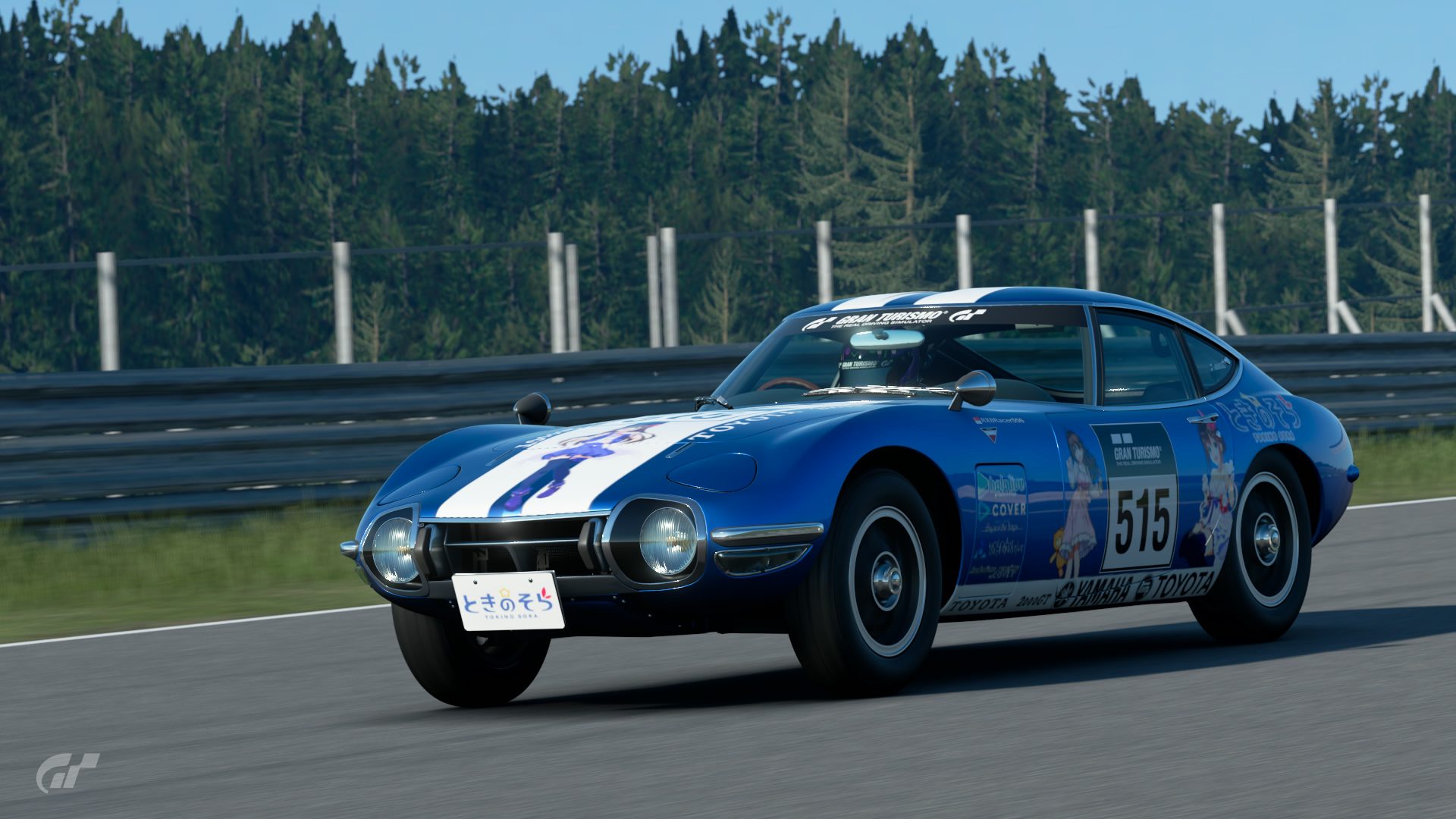
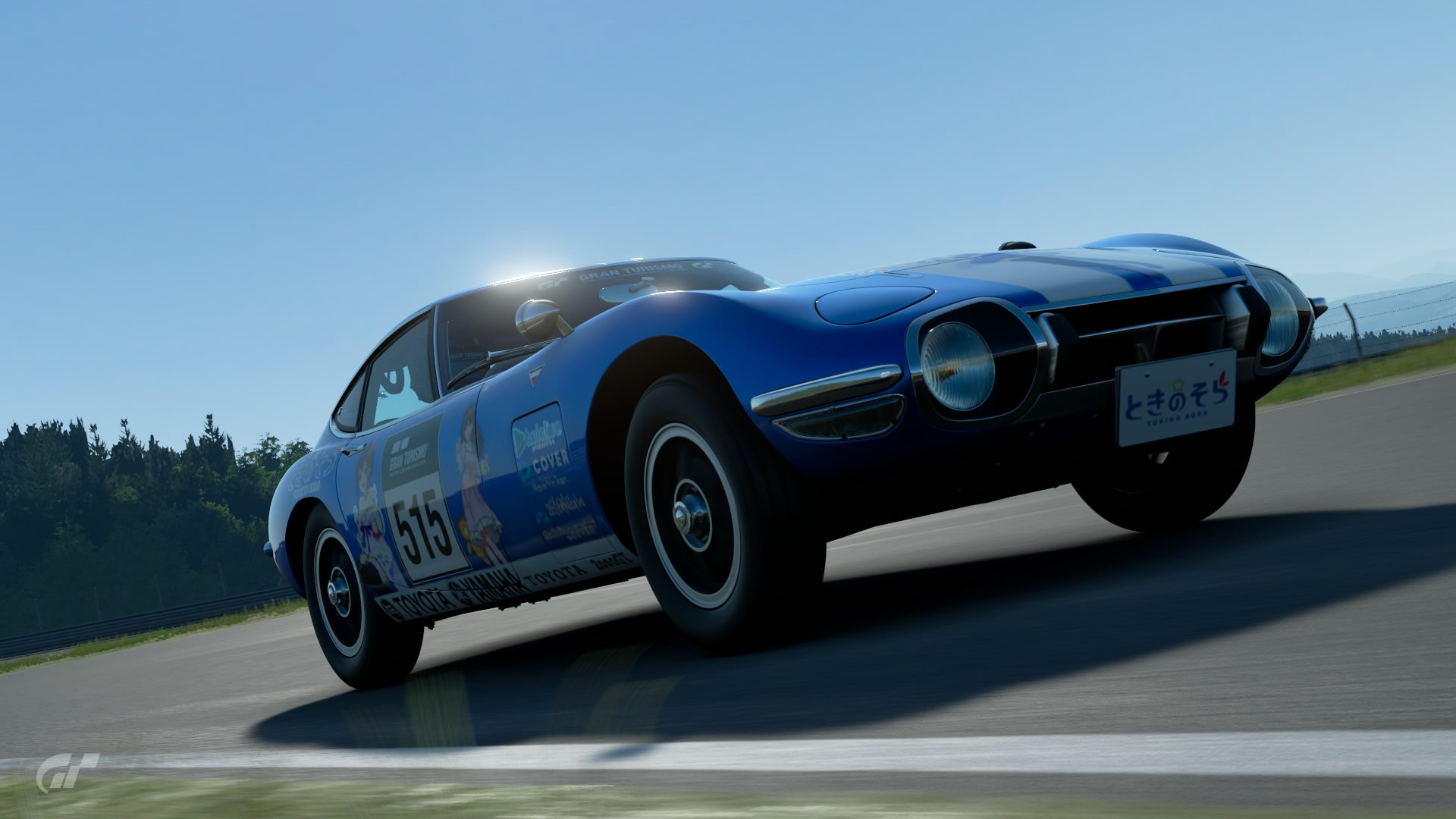
A collaboration between Yamaha and Toyota, the 2000GT is Japan's first supercar.
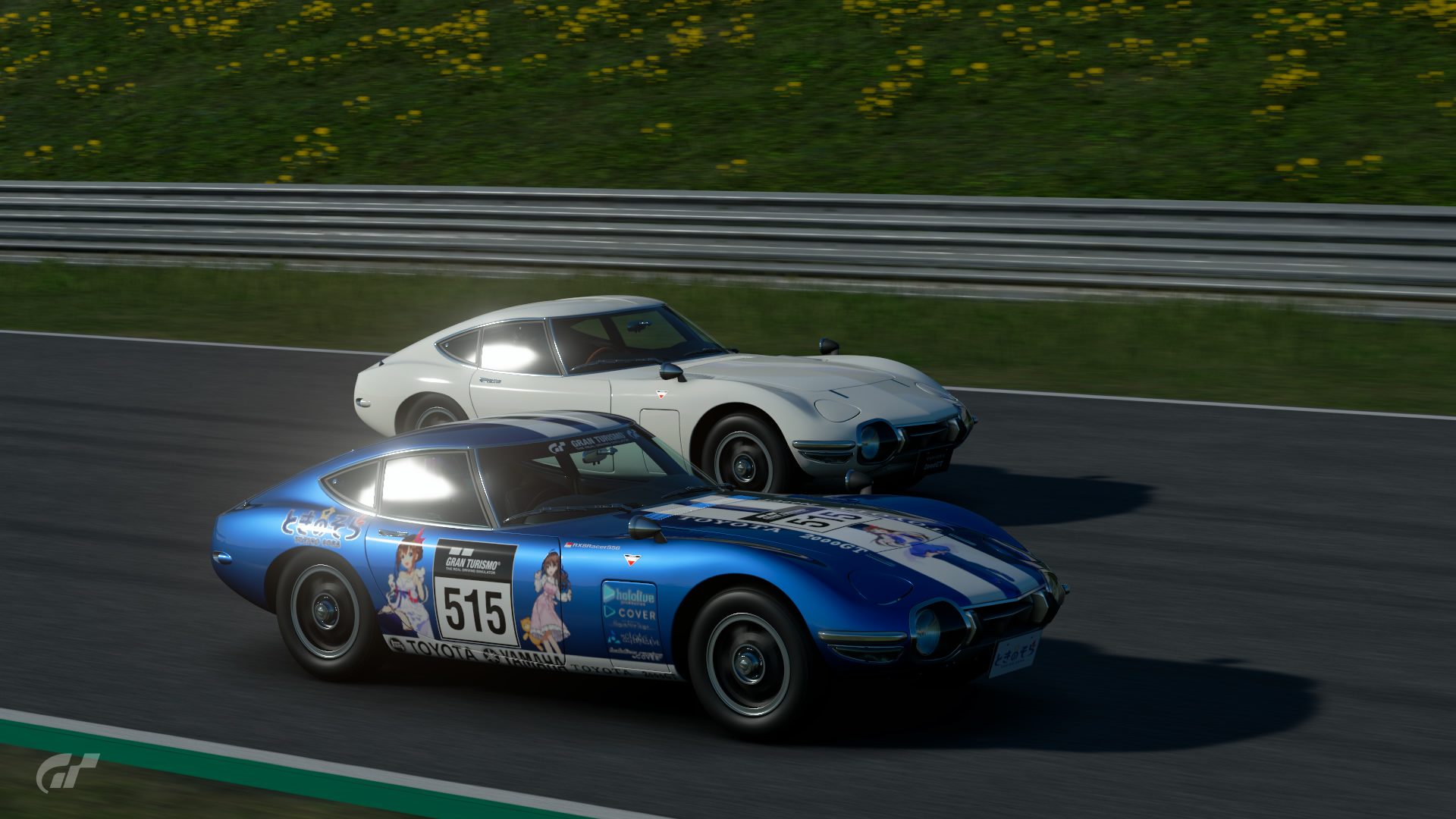
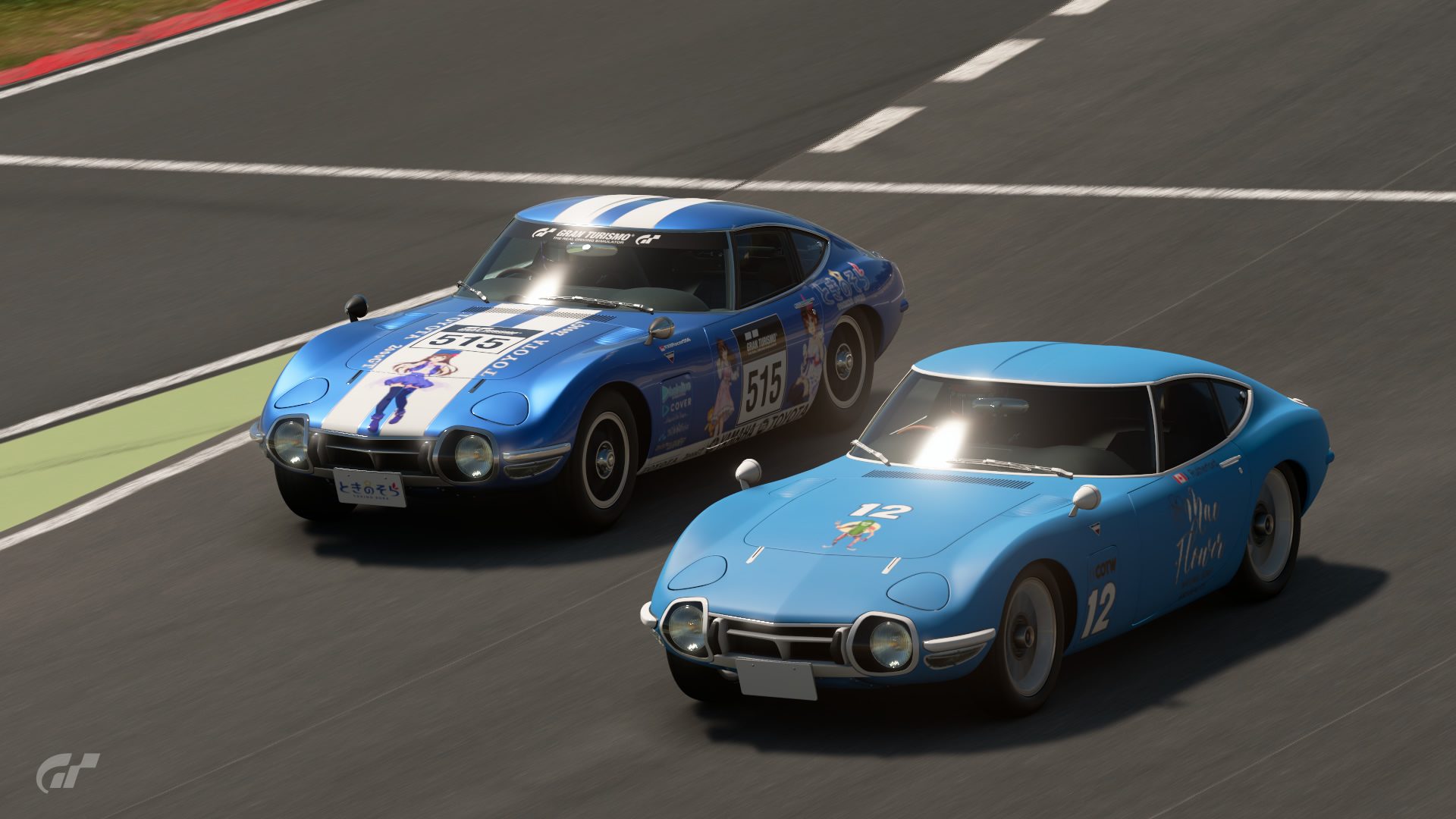
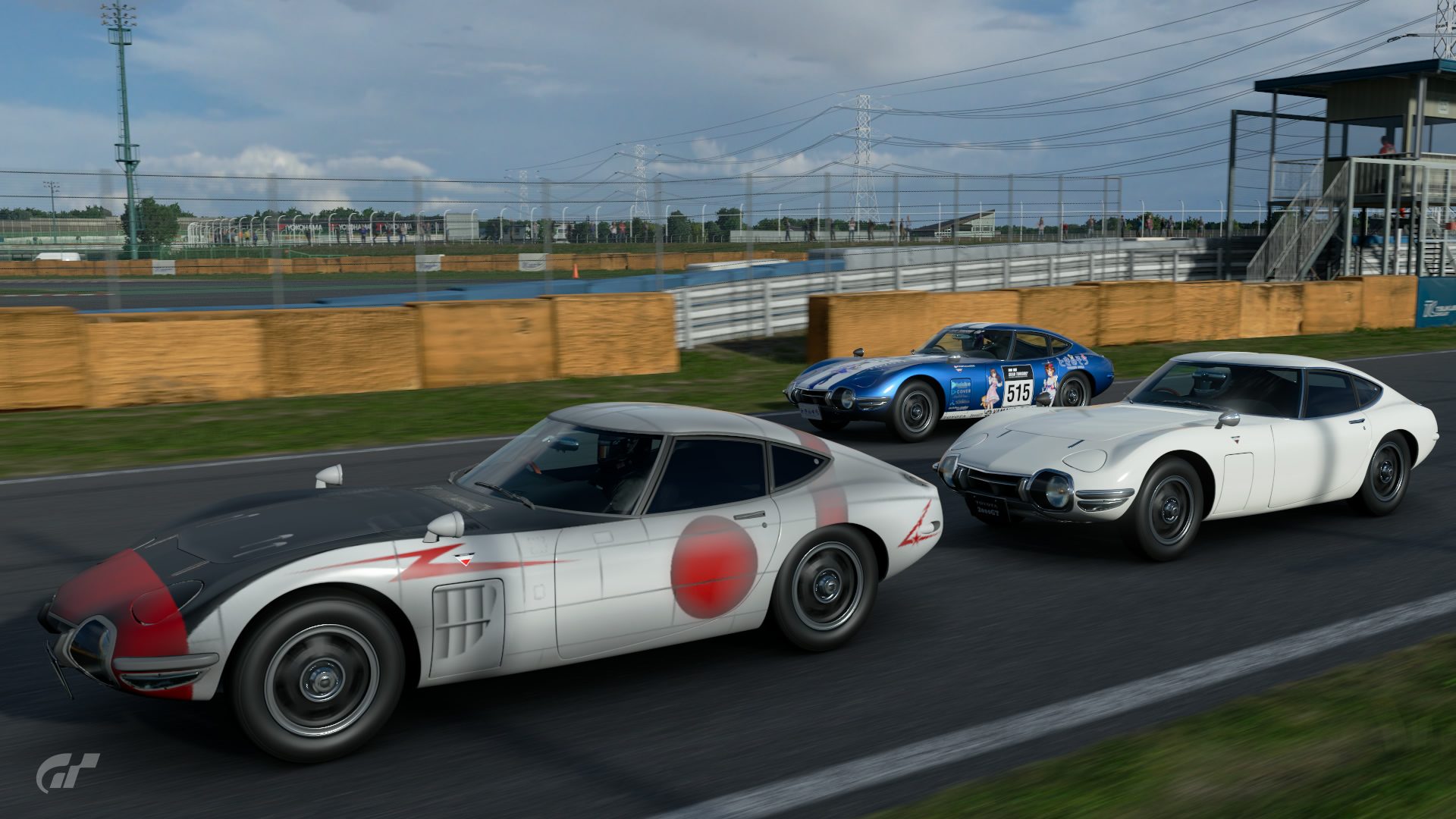
Going wheel to wheel with other 2000GT racers.
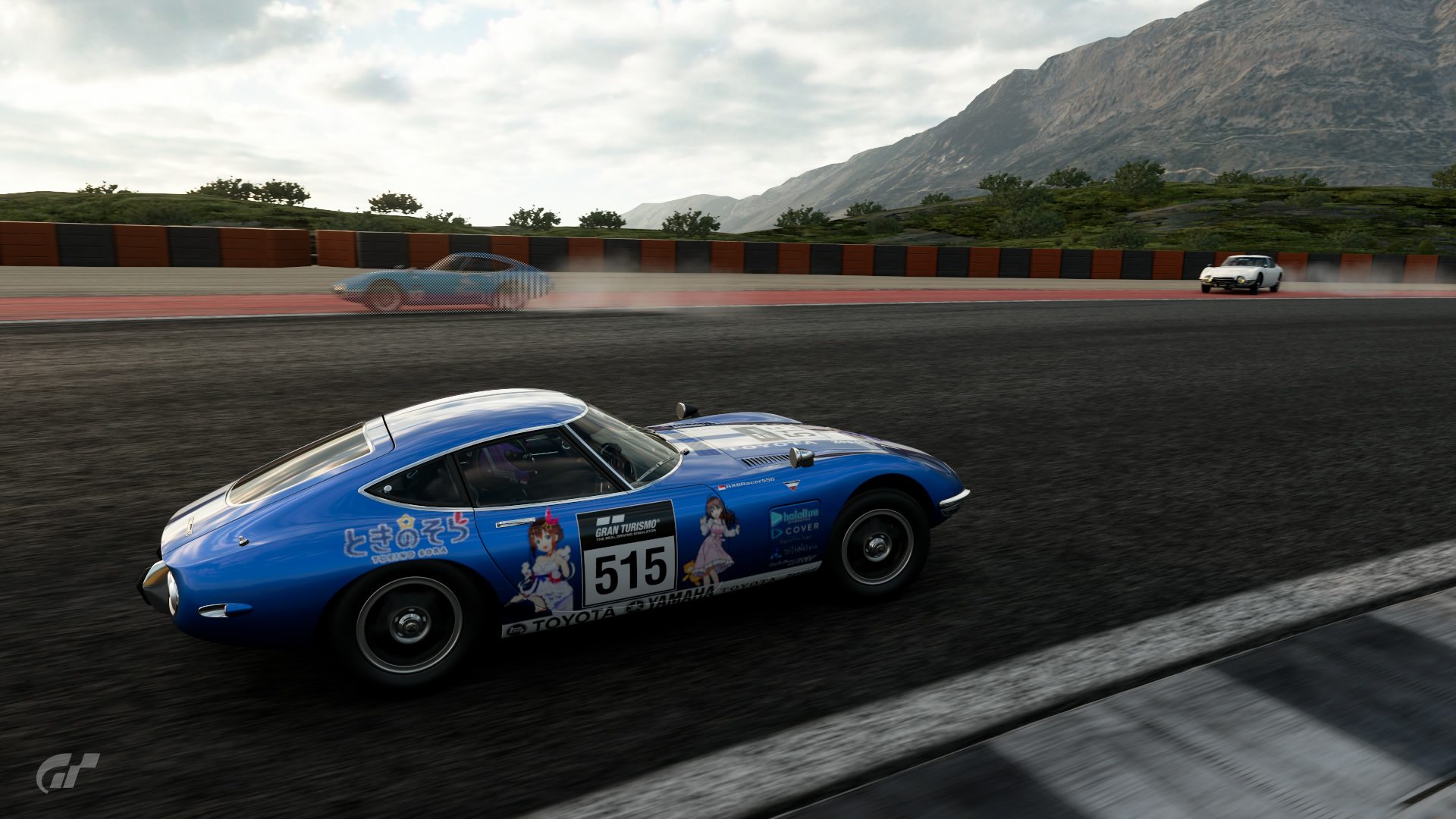
Two other 2000GTs perform donuts to celebrate me taking 3rd off of them.
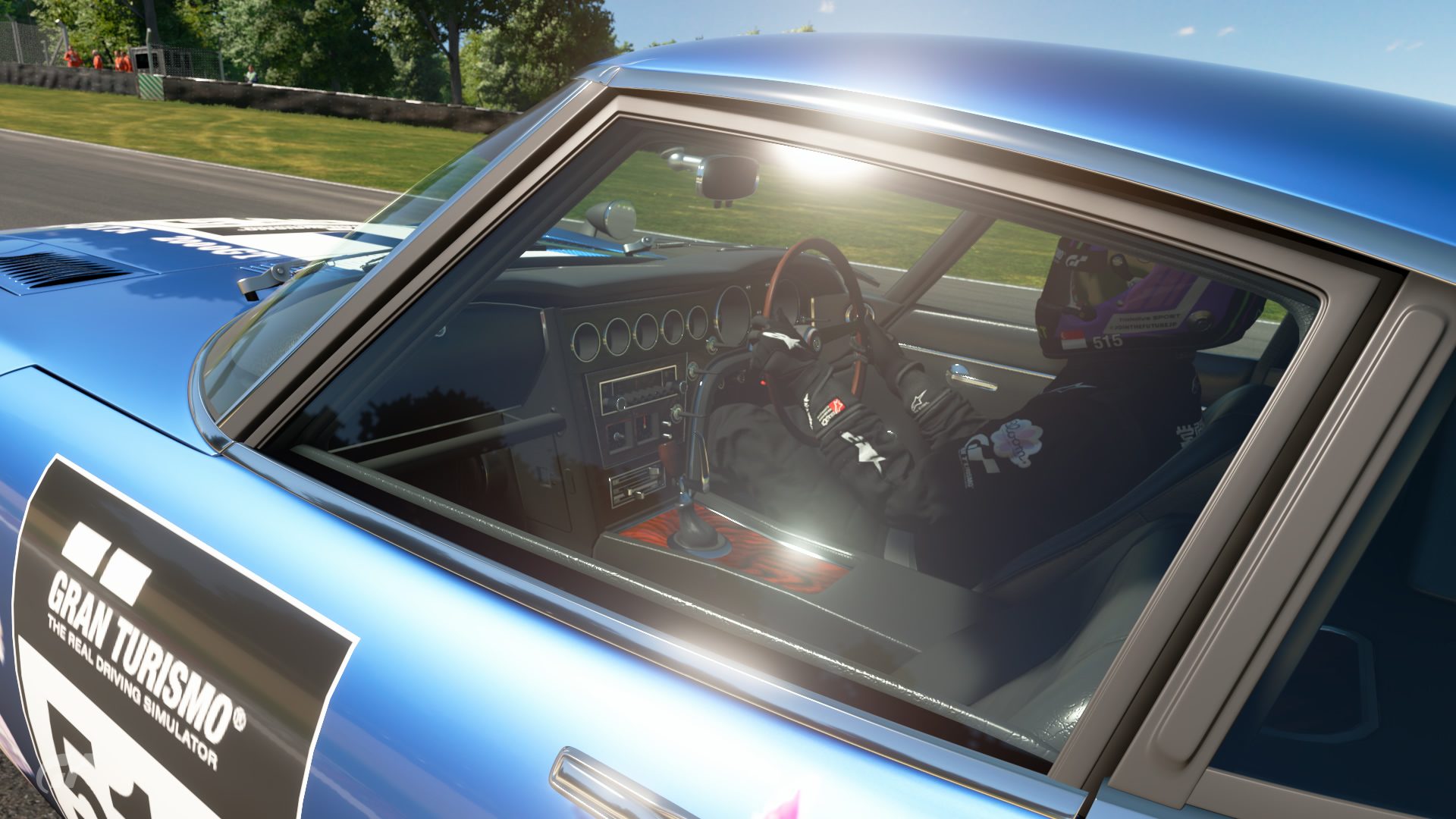
A peek into the 2000GT's immaculate interior, furnished with wood from the master craftsmen at Yamaha.
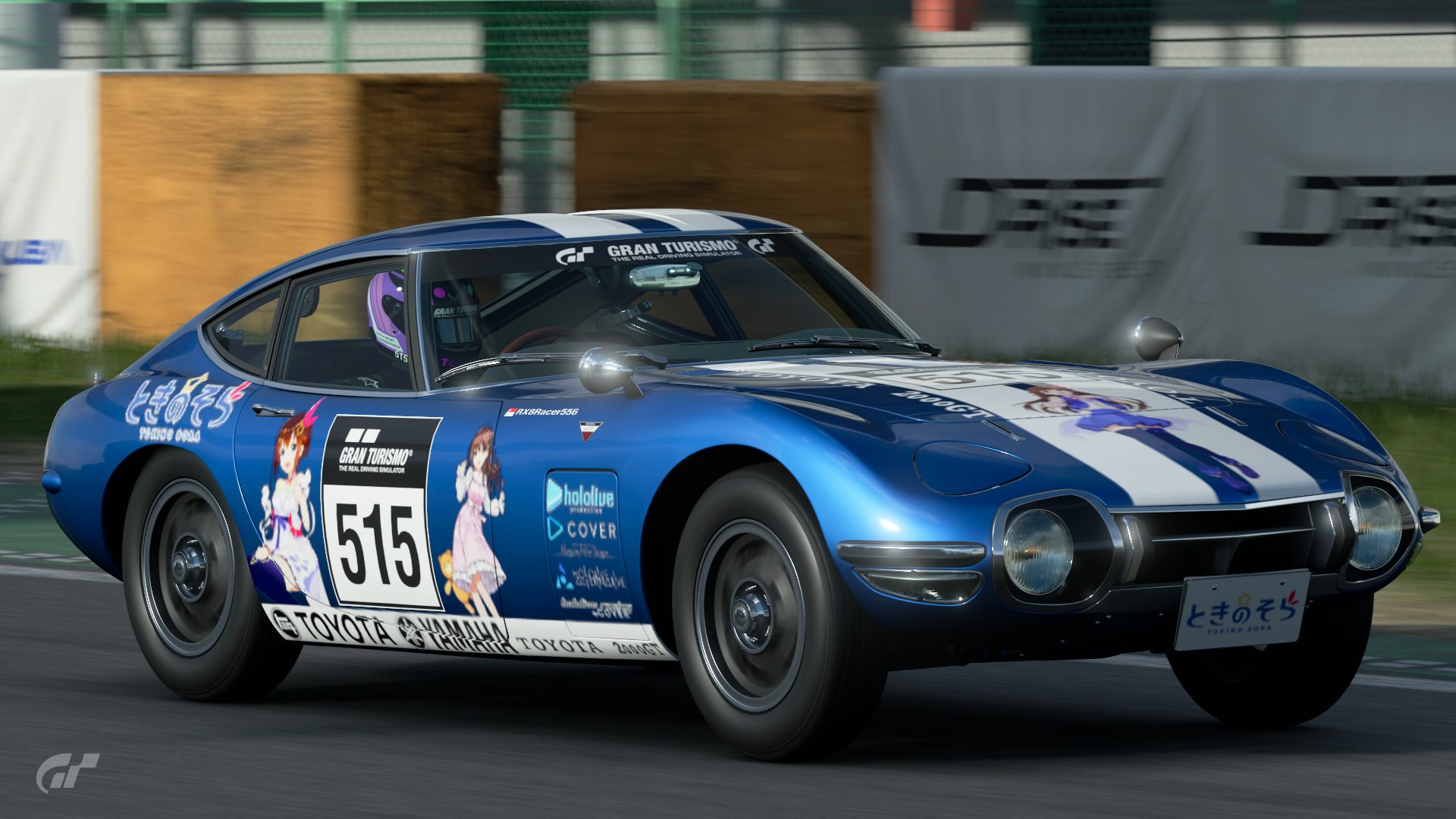
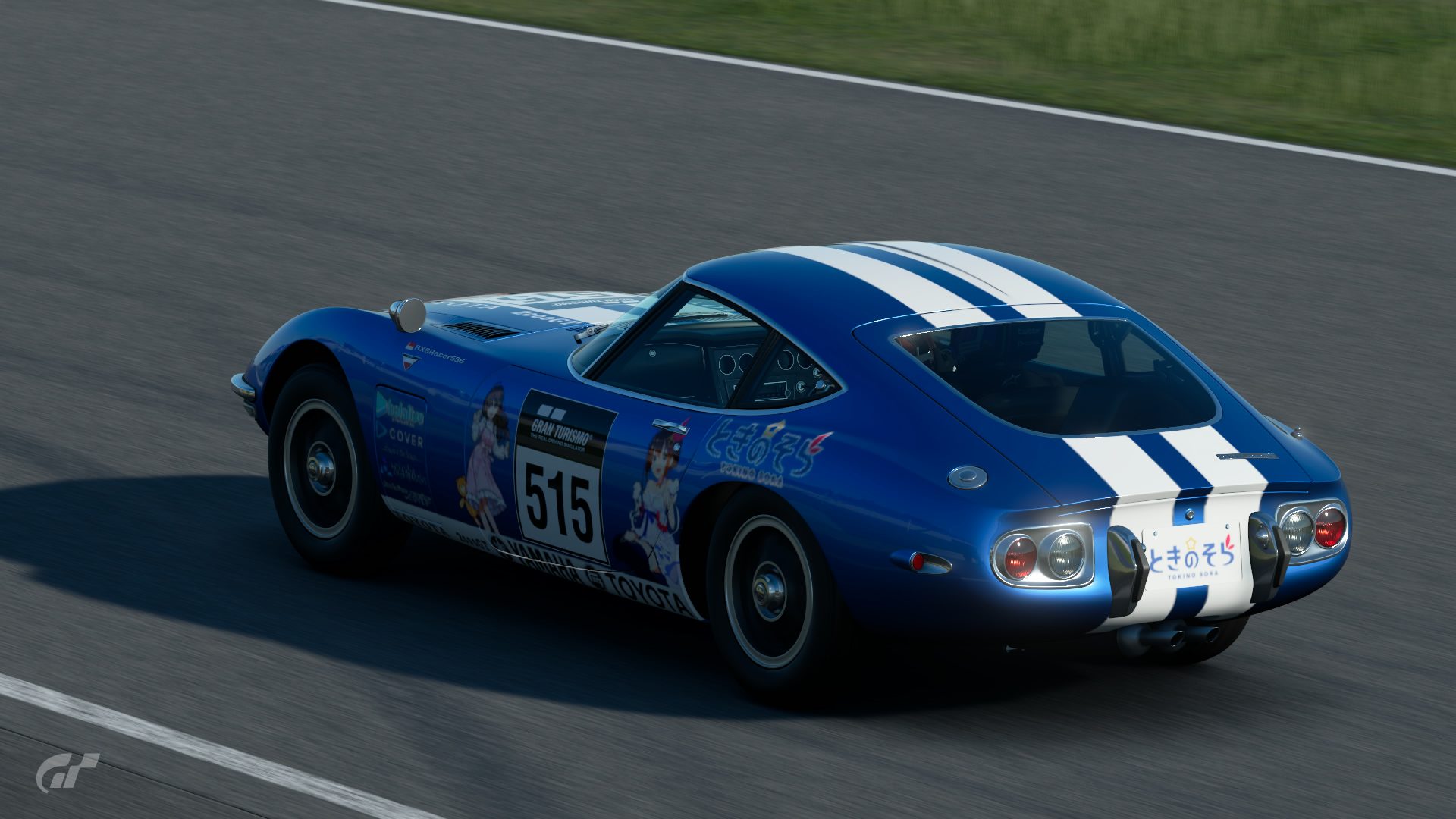
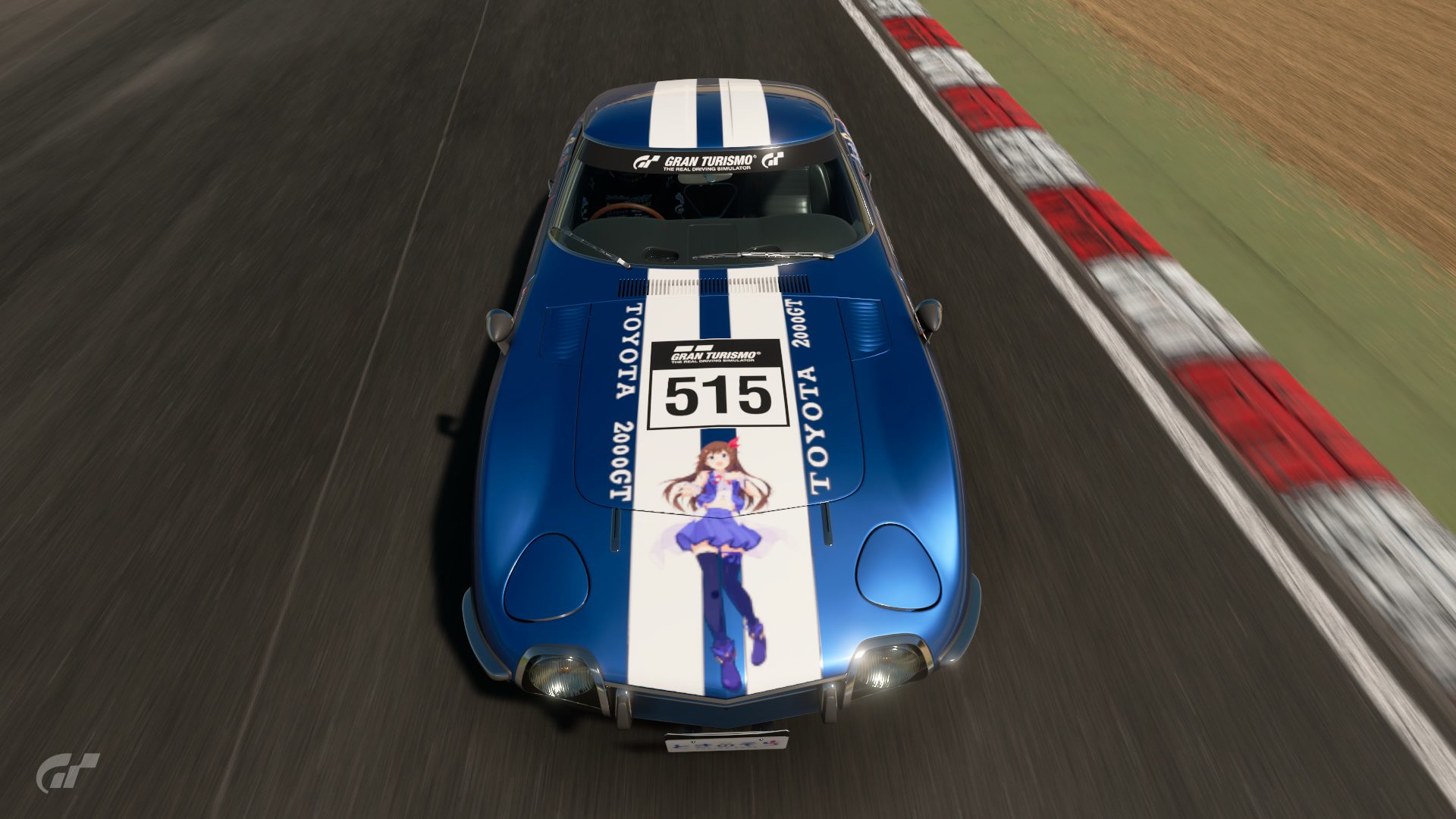
My itasha livery is a retro-styled affair featuring white stripes on blue body and Hololive's first talent, Sora Tokino.
Setup: Comfort Soft tyres, TCS 1, everything else stock
The Toyota 2000GT is a dream to drive. The car is surprising easy to handle, with slides being easy to control provided that you avoid entering corners at excessive speeds. First gear is to be avoided outside of grid starts; the car bogs down when shifting from 1st to 2nd out of corners. Other than that, the car tackles corners with ease and a predictable manner.


A collaboration between Yamaha and Toyota, the 2000GT is Japan's first supercar.



Going wheel to wheel with other 2000GT racers.

Two other 2000GTs perform donuts to celebrate me taking 3rd off of them.

A peek into the 2000GT's immaculate interior, furnished with wood from the master craftsmen at Yamaha.



My itasha livery is a retro-styled affair featuring white stripes on blue body and Hololive's first talent, Sora Tokino.

